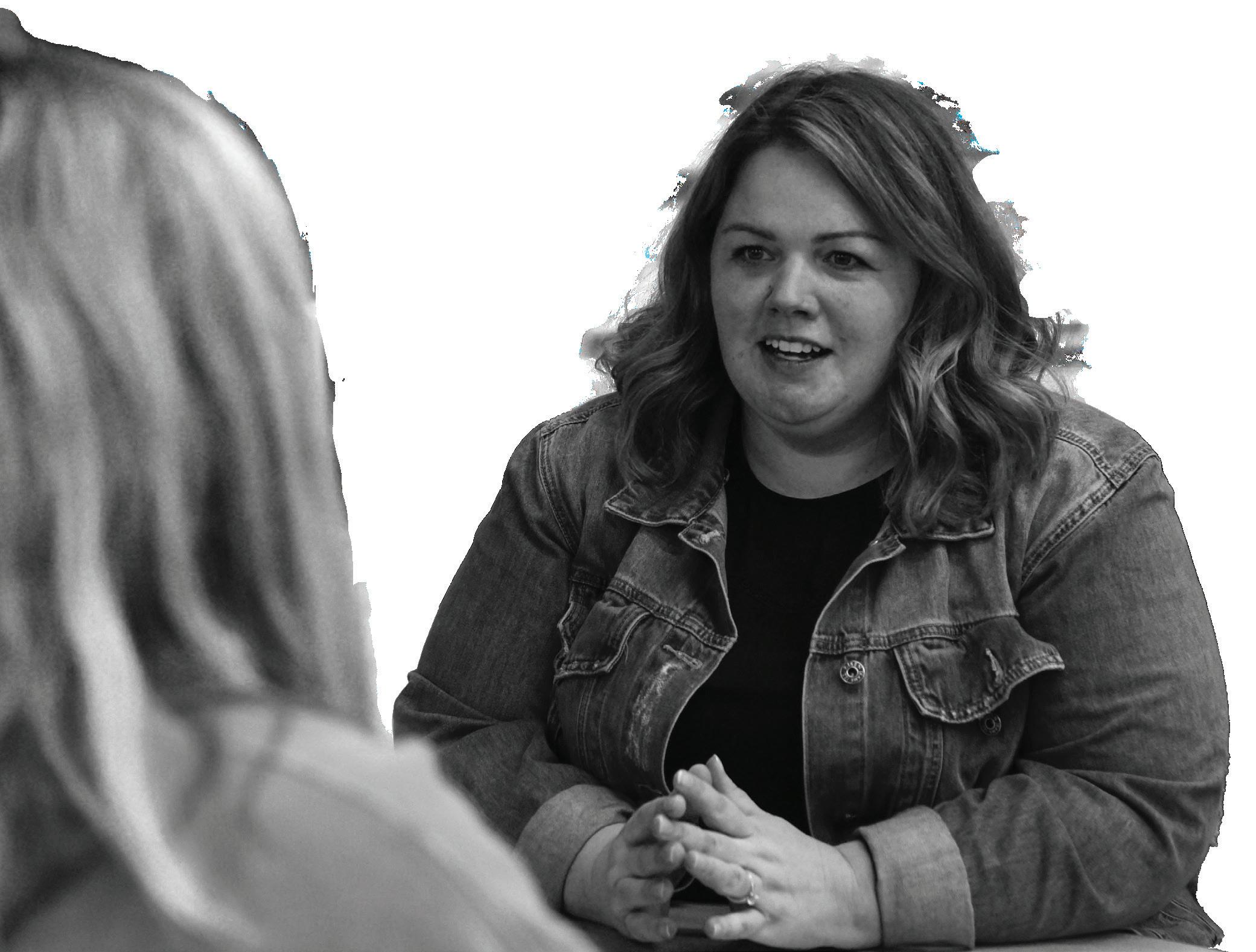

THE HARBINGER design by katie murphy cover design by francesca stamati



THE HARBINGER design by katie murphy cover design by francesca stamati
at a Missouri high school
 SENIOR SIM KHANUJA
SENIOR SIM KHANUJA

EVERYONE’S TALKING ABOUT the Greentree Parade. It just happened last weekend, where local businesses and sports teams ride foats across the downtown Kirkland Park. There’s fun booths with food and jewelry and music. It’s a recurring tradition that really shows our school spirit.
Peyton Moore
ASST.
Greyson Imm
Lyda Cosgrove
Heitmann
Greyson Imm Katie Murphy
Kissick
POST
Bansal
Lynn Anna Mitchell
ASST.
Bridget Connelly
Marissa Liberda
Rachel Bingham Hadley Chapman
Crosser
Liv Madden Riley Scott
Siegel

VIDEO

Lee
Krause
Vogel Paige Zadoo
Connelly
ONLINE
Ben Bradley
Lindberg
ONLINE OPINION
Anderson
NEWS
Chabanis
Gooley
Moore
Abby Lee
Hassan Sufi
STAFF
David Allegri Isabel Baldassaro Luke Beil Larkin Brundige Maggie Condon Mary Gagen Lily Simmons Gracie Takacs Connor Vogel

TOP LEFT The Kirkwood marching band plays at the Greentree parade. guest photo by I katie bowers
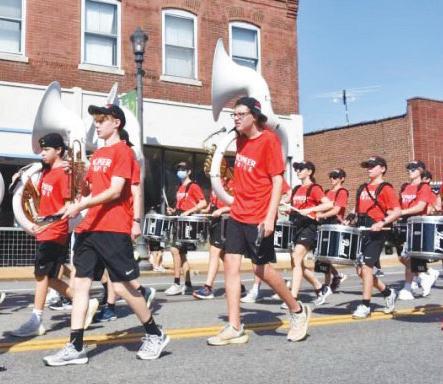
TOP RIGHT Kirkwood’s football team celebrates their 65-0 win over in their annual Turkey Day rivalry game — a Thanksgiving day tradition since 1907 — taking home the special bell trophy. guest photo by I marianthe meyer

BOTTOM LEFT A junior participates in one of Kirkwood’s traditions, where each class decorates a hallway of the school a different theme. This year, the juniors’ class theme was Mario Kart. guest photo by I coco legrand
Lucy Wolf Ada Lillie Worthington PAGE DESIGNERS
Afa Akwana Sofia Blades
Adya Burdick Ava Cooper Grace Demetriou Elle Gedman Olivia Hawley Maggie Klumpp Veronica Mangine Kai Mcphail STAFF ARTISTS
Sofia Blades
Madi Maupin
PHOTO MENTORS
Riley Eck Julia Fillmore Claire Goettsch
Caroline Martucci Emily Pollock Mason Sajna STAFF

PHOTOGRAPHERS
Kate Beaulieu Lydia Coe Audrey Condon Sabrina Dean Charlotte Emley Julia Fillmore Molly Miller Clara Peters Tristen Porter Ella Ralston Jill Rice Mason Sajna Seri Steinbrecher Lili Vottero MJ Wolf Amelie Wong

WITH THE SUICIDE rate steadily increasing each year since 2000, the media has developed a morbid fascination with the tragic concept of killing onself. It seems that each time we open Netflix and Twitter, yet another show or hashtag normalizes suicide.
Inspired by TV shows like “13 Reasons Why,” the media frenzies over celebrities who have taken their own lives. Social media posts are far too comfortable in spreading sensitive — and often false — information.
Depictions of suicide in the media are often oversimplified, romanticized and graphic. There shoudn’t be a concern of an increase in the suicide rate simply due to reading an article or watching a movie that depicts graphic content. However — due to wrongful depictions of such tragedies — there unfortunately is.
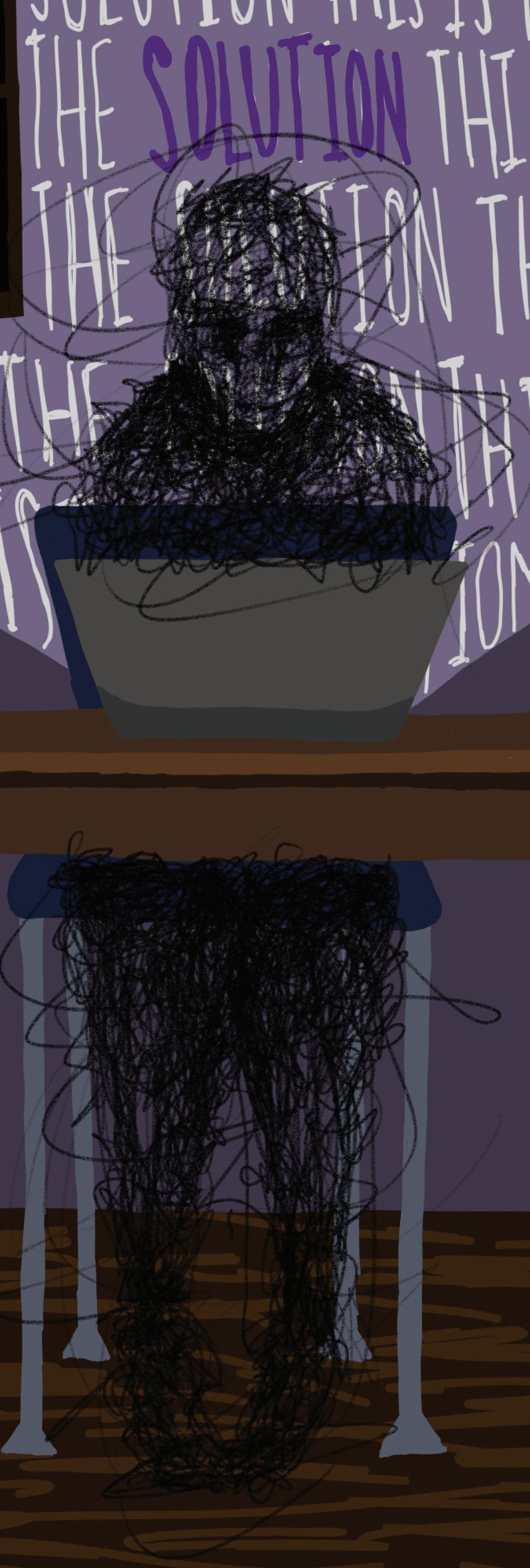
dies by suicide, as proved in the case of Kurt Cobain. When Cobain was found dead in 1994, Seattle news stations covered suicide prevention and mental health resourcess, focusing on his family’s pain following his death rather than the death itself. The insubstantial change in suicide rates after Cobain’s death clearly reflect the findings of studies conducted on the contagion effect — proving that media coverage can have disastrous effects.
The reason certain deaths have less national impact comes down to how sugar-coated and glorified each suicide is portrayed. If reporting is done well and specific phrases like “commit suicide” are avoided, details of the manner of death are withheld and the person is recognized for more than their suicide, then the contagion effect is far less likely to occur, according to licesned Children’s Mercy social worker Michelle Camerer.
Recently, social media is largely responsible for perpetuating the narrative of the “beauty in suicide.” For instance, Twitter tags such as #cutting skyrocketed 500% since October 2021, according to the misinformation index Network Contagion Research Institute.
Trivializing a form of self-harm is damaging to those who come across these posts. Oversharing graphic details of self harm or suicide can be triggering for those who are working to free themselves of suicidal thoughts.
That’s not to say that we shouldn’t discuss suicide at all. Sharing thoughts and feelings can be beneficial, but generally speaking, according to Camerer, suicide becomes an issue for those who struggle with a buildup of long-term emotional issues or mental illness — not in people who have been wronged in 13 individual events, as portrayed and defended by “13 Reasons Why.”
SCAN ME WEBSITEThe members of the editorial board who agree with the viewpoint of the editorial are represented by for, and those who disagree with the viewpoint are represented by against.
The Harbinger is a student run publication. Published editorials express the views of the Harbinger staff. Signed columns published in the Harbinger express the writer’s personal opinion. The content and opinions of the Harbinger do not represent the student body, faculty, administration or Shawnee Mission School District. The Harbinger will not share any unpublished content, but quotes material may be con frmed with the sources. The Harbinger encourages letters to the editors, but reserves the right to reject them for reasons including but not limited to lack of space, multiple letters of the same topic and personal attacks contained in the letter. The Harbinger will not edit content thought letters may be edited for clarity, length or mechanics. Letters should be sent to room 413B or emailed to smeharbinger@gmail.com.
After the release of “13 Reasons Why” — which poorly illustrates the mental state of teens struggling with suicidal ideation or self-harm — suicide rates hit a 33-year high in the U.S. This is the opposite of what the show was trying to accomplish in following the aftermath of a teen suicide. The responsible phenomenon is called the media contagion effect.
According to the contagion effect, celebrity suicides in film and TV correlate to an increase in widespread suicide rates. The phenomenon’s impact can be small-scale, like hearing about back-to-back suicide attempts at a neaby school, or big enough to cause a 10% increase in suicide rates over five months, like in the case of Robin Williams’s suicide.
Reports included specific details of his suicide method that sparked a 32.3% increase in deaths by the same method, according to a study conducted by PLOS ONE, an openaccess and rigorously peer-reviewed online journal.
However, the contagion effect doesn’t apply every time a celebrity
However, oversimplification of suicidal ideation is equally detrimental to those struggling with mental health. Claiming that suicide is caused by only a few events invalidates serious mental illness leading to suicide, causing confusion when differentiating one’s own valid, yet temporary struggles from severe cases of mental illness.
A tendency to categorize a suicide as poetic or beautiful not only portrays events incorrectly, but also recklessly insinuates that suicide can be justified.
Apple TV’s hit show “Ted Lasso” is one of the few shows which aptly discusses mental health by addressing how suicide can affect families. It accurately depicts mental health treatment as a process that can’t be resolved in just one episode. The show doesn’t justify characters’ mental health complications, but instead lays out realistic ways to treat and cope with these struggles.
By portraying suicide in a trivial or romanticized way, people may not view legitimate mental health issues as being cause for concern. If someone’s experiences aren’t reflected in the media, they may avoid getting help because they assume they don’t need it.
These factors push the notion that suicide is a correct or reasonable reponse to trauma or mental health struggles without offering up alternative solutions or even calling suicide what it really is: a tragedy. If they do provide content warnings or resources, it’s in a performative way that doesn’t begin to offset the harmful effects of the content itself.
Those struggling mentally shouldn’t find a reason to die in a news article, a movie or on social media.
By following media guidelines, seeking input from professionals when producing content and calling for social media platforms to regulate suicide-related content, those who are struggling can find better longterm solutions to their mental health challenges.
con•ta•gion ef•fect process by which exposure to suicide or suicidal behavior of one or more persons influences others to attempt suicide
NOT
Glorification of suicide in media is detrimental to those struggling mentally
photos by amelie wong
RIGHT Senior Sylvia Bunde runs to get hit the ball.
LEFT Senior Rachel Bingham sets herself up for her serve at practice.
GIRLS VOLLEYBALL ’S SENIOR night is scheduled for a match against Shawnee Mission South on Oct. 6.
As the season closes, volleyball head coach Alexander Henton is preparing for the senior night and recollects how the seniors performed this year.

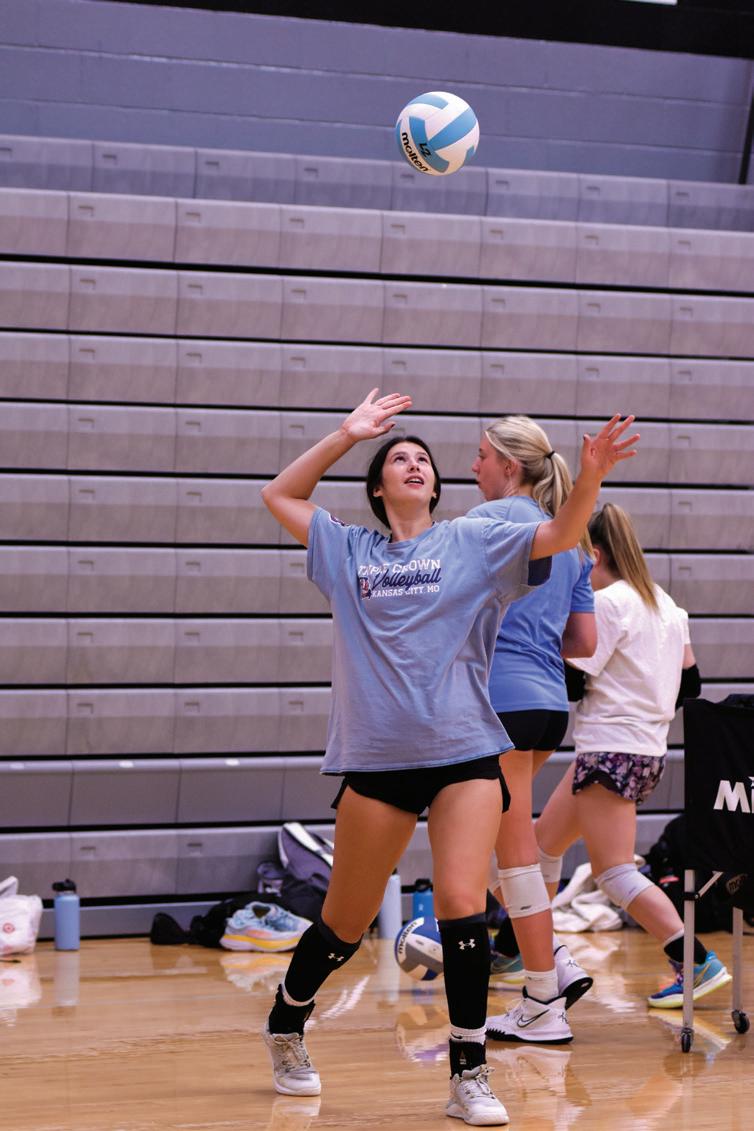
“The seniors this year are special,” volleyball head coach Alexander Henton said.
The senior lineup is versatile in how the athletes work together, Henton said.
“It’s a unique blend,” Henton said. “We have Rachel, who’s a four-year varsity player, Ava, who is a three-year, Vivian who is a two-year, Annie and Avery are first year varsity players. It’s an exciting mix of girls, and they all have similar personalities in terms of how they function on the court.”
Throughout the season, the seniors’ ability to keep the ball down and score
ON NOV. 8, Missouri citizens can vote on the legalization of recreational marijuana.
The current law in Missouri states that marijuana is only legal with a state-issued medical card, but the Missouri legislature is looking to legalize the use for recreational purposes for reasons such as the increase in state revenue, the decriminalization of the substance and hopefully an increase of population, according to John Payne, campaign manager
for Legal MO 2022.
Marijuana’s legalization will stop prohibitions on purchasing, possessing, consuming, using, delivering, manufacturing or selling marijuana for personal use by any adult over the age of 21, according to the new 39-page Missouri legislation bill.
Even though medical marijuana is legal in Missouri, possession and sale are illegal in Kansas. Possession and/or sale is a Class B misdemeanor punishable by up to six months in jail and a fine of up to $1,000 for first-time offenders, according to Missouri
state law.
Missouri can expect similar effects from states who have already legalized the substance according to the CATO institute. Colorado — a state known for loose cannabis laws — saw a $3.5 million dollar increase in state marijuana tax revenue after years of legalization, according to the Colorado State Revenue Department.
Junior George Anderson thinks that legalizing weed will boost Missouri’s economy.
has been highlighted in games and practices. Because of their work ethic and aggressiveness, Henton is sad to see them go.
“This group has played this year, and it’s hard to believe it’s already over,” Henton said. “We have done well this year and we have been playing well this season.”
The team has played well this year with a 14-10 record and they are hoping to carry their win streak on through senior night.
“We have a great group of girls this year. We all really like each other and there’s good chemistry,” senior Vivian Riehl said. “The team this year is the best team I’ve been on and we all have enjoyed playing with each other this season.”
“Honestly, I think legalizing weed will help Missouri,” Anderson said. “With the condition, the roads, the crime I think the city could benefit from additional tax revenue. I think it may draw more people to live there, and hopefully help with the economy.”
Those looking to register to vote on legalizing marijuana can register online or in-person in their town’s city hall.
PRINCETON UNIVERSITY HAS raised the minimum threshold for free tuition from $65 thousand to $100 thousand dollars of annual household income which will take effect in the fall 2023 semester, allowing more students to attend the university.
Princeton’s financial aid program is designed to encourage all qualified students
— regardless of financial circumstances — to consider applying for admission to Princeton, according to the school’s website.
Princeton offers substantial financial aid for students whose annual household income is up to $180 thousand a year and can allow students to receive multiple grants and supplemental aid. Due to their generous financial aid program, the university claims
83% of their seniors graduate debt-free.
“Our generous financial aid has ensured the continued and growing enrollment of a diverse group of undergraduates from low and middle-income backgrounds,” Princeton states.
The new tuition change helped to convince senior Presley Connelly to apply to Princeton.
“I was mainly looking at Ivy league schools, but the tuition was just too expensive,” Connelly said. “I then started looking at Princeton, and I was drawn in by their math program, but the more I researched, I found the amazing financial aid program.”
BREAKING
SMSD will be offering open enrollment to all students starting June 2024
G OV. LAURA KELLY signed House Bill 2567 on May 16 which included funding for Kansas public schools and an open enrollment policy being put into place in the 2024-25 school year.
The policy would allow students grades K-12 to attend any school within Kansas. This includes being able to attend East from anywhere in the state.
“We haven’t gone over it extensively as a district or as a staff yet, so we don’t have a lot of information,” Principal Jason Peres said.
Currently, all Kansas public school districts state that if a student lives within the boundaries of the district they have to attend the assigned public school in their area unless they officially transfer to another school within the district.
However, with the new open district policy, students will be able to attend any public school they’re accepted into regardless of where they live.
According to the Kansas City Star, each school district is expected to limit the number of kids they can take from outside the district with siblings of current or former transfer students and those already in the district being prioritized over newlyenrolled students.
Students looking to transfer must fill out all necessary forms and paperwork before the beginning of the 2024 school year and continue attending their current school until they get accepted, according to the Kansas City Star.
Districts will also be required to hold
public meetings notifying local families and potential transfers of their policies, capacity and any other relevant information. All meeting information will also be uploaded to the district websites for easy access and reference.
Once transfer students are accepted into a given school, they can expect to remain there until graduation unless any issues with attendance, suspension or expulsion arise.
The bill specifically states that districts can’t judge students based on “ethnicity, national origin, gender, income level, disabling condition, proficiency in the English language, measure of achievement, aptitude and athletic ability.”
However, this doesn’t bar students from attending a school for a certain program or sports team specific to that school. Districts also aren’t allowed to accept or deny students based on any learning disabilities or mental health issues — a growing concern for parents and larger school districts.
If a student applies and is not accepted, they will receive a letter outlining why they were not accepted. This could be because the school has reached their capacity or the student’s past records.
Once admitted into a transfer school, students will be expected to coordinate their own transportation because schools are not required to provide transportation to and from school to any location outside the district.
While some parents are happy with the new bill and the potential for their student to receive an education at a school more fitted for them, SMSD’s Chief Communications Officer Dave Smith has openly opposed the

decision.
Map of current SMSD boundries, with East starred
Smith’s concerns include additional administrative responsibilities and a general lack of need for the bill. He has also expressed concern about funding for more students and service costs.
Sophomore Maren Dickerson has been a transfer student since kindergarten. Originally allotted to attend Shawnee Mission North, she now attends East.
“I really like being a transfer student because East has so many opportunities and for someone from another district to also have access to those opportunities is great,” Maren said.



There is also concern from local residents about a potential tax increase. Residents are worried that with increasing student populations, taxes will rise due to the strain on school resources.
Districts including SMSD, Olathe, Kansas City, Kansas and Blue Valley are all opposed to the new bill according to KMBC news, but many smaller districts support it.
More information specific to each school will be released after the public meeting is held on a to-be-determined date.
East staff voices their thoughts on open enrollment coming to East
STUDENTS have wildly different access to quality education based on where their parents can afford to live. Open enrollment is one of the quickest ways to fx this injustice.COLEBANK EMILY
MATH TEACHERI HAVE SEEN similar things happen in other states and it has never been successful. There is no offcial word from for how we will handle this yet. I think everyone is sort of grappling with how they understand it.
ASSOCIATE PRINCIPAL
I UNDERSTAND THE point. I think that from a logistics stand point, it’s a bit of a nightmare. I think that the idea is OK, but I think that actually do ing it is going to be diffcult.APPIER STEVEN
SM East SM South SM West SM Northwest SM NorthTHE PERFECTLY DIVIDED Senate faces debate over the Respect for Marriage Act that will codify the the Supreme Court’s decision to legalize same-sex marriage in 2015, with huge potential effects on LGBTQ+ students at East.
arranging laws and rules into a systematic code
Members of Plus Club are worried that they won’t be able to marry the person they love based solely on their gender according to Plus Club President and senior Jeanne Ozkan. This comes after the Democratsponsored House bill passed with 267-157 in July with the bipartisan support of 47 Republicans.
Bipartisan support for the bill goes beyond the walls of Congress, with 71% of Americans supporting the right to same-sex marriage and 25% objecting due to moral or religious reasons, with the remaing 4% of those polled offering no opinion on the issue — according to a poll by Gallup.
This bill doesn’t only expand marriage rights, but also repeals the 1996 Defense of Marriage Act, which defined marriage as a union between only a man and woman. The law banned the federal government from recognizing same-sex marriages and disqualifed couples from federal benefits like joint tax filing and spousal benefits such as Social Security, Medicare, disability and visitation rights in instances of grave illness, according to the Wall Street Journal.
Ozkan believes that Republican opposition to the bill stems from the influence religion has on American voters.
“I don’t believe America is secular in any sense of the word,” Ozkan said. “Religion is something you go to when you want to learn your morals and values. Those teachings will directly affect your political views and your vote on election day.”
its decision.
AND AS WE become more polarized from each other, eventually nothing is going to get done.
The Senate requires 60 votes to legally pass the bill, meaning ten GOP Senators must vote in favor. The Respect for Marriage Act may not have an immediate or significant impact on East students right now, but it has made Queer History Club President Jo Wilson-Head question the future of many LGBTQ+ students.

 JO WILSON-HEAD
SOPHOMORE
JO WILSON-HEAD
SOPHOMORE
“Roe versus Wade has definitely shown a more extreme Republican Party and more extreme Democratic Party so it becomes harder and harder to [find bipartisan support] on these issues that are becoming more at the forefront of our minds,” WilsonHead said. “And as we become more polarized from each other, eventually nothing is going to get done.”
President’s of LGBTQ+ clubs at East share ways to better support the LGBTQ+ community
“Hopefully, this is a [bill] that we’re hopefully never going to have to think about, but I know I for one am going to be moving out of the country if that ever happens,” Wilson-Head said. “And I know a lot of people that feel the same way.”
[THE MARRIAGE Equality Act] is very important, no matter what happens. There is always going to be backlash and homophobia with these bills. But we all must try to pro tect the rights of LGBTQ+ people.

 JO WILSON-HEAD
SOPHOMORE
JO WILSON-HEAD
SOPHOMORE
The push to pass this bill comes nearly three months after Roe v. Wade was overturned. In his concurring opinion, Justice Clarence Thomas stated that the court should reconsider former precedents, specifically mentioning Obergefell versus Hodges, the basis of the constitutional right to same-sex marriage that the court used to make
In the face of this crucial bill, WilsonHead believes it’s vital for the public to be aware of the discrimination queer people face in this country.
“[The Marriage Equality Act] is very important, no matter what happens,” WilsonHead said. “There is always going to be backlash and homophobia with these bills. That’s just part of our culture and society in general. But we all must try to protect the rights of LGBTQ+ people.”
USE [YOUR] VOICE and talk to representatives. I know it’s super scary, but they really do want your input. They are there to represent you. Make sure they are doing that.
LISTEN, BE RESPECTFUL and don’t be afraid to make LGBTQ+ issues a topic of conversation. It really means a lot to LGBTQ+ people to have supporters who are willing to stand up for them.
The senate prepares to vote on the Respect for Marriage Act that will provide protection for gay marriage
design by paige zadoo


Students answers “controversial” questions
YES, BECAUSE IF I get hot, then I can just take the comforter off, and I have the top sheet.
KATIE COOK FRESHMAN
SENIOR
GIF WITH A g, if you say anything else, you’re just wrong.
SENIOR

VEGETABLE . TO ME, anything you can eat with ranch is a vegetable.
OK, SO IF it’s a smaller-sized pasta, a spoon is absolutely better than a fork, because it makes eating it way faster.
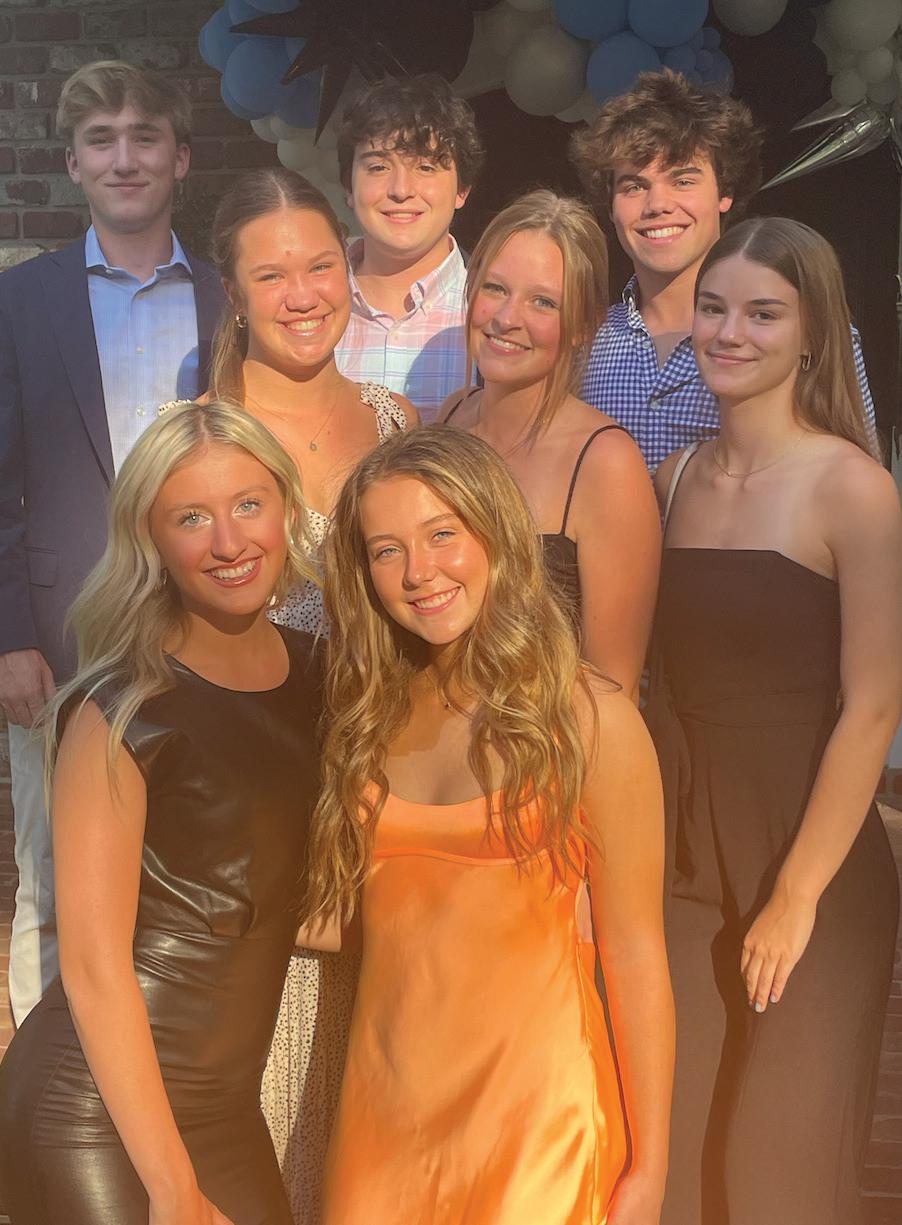
SHARE Execs answer Buzzfeed quizzes to find out what dessert they are, their sleepover personality and what type of corn they are
mochi one who stays up till sunrise mexican street corn
créme brulée one who has gossip to tell mexican street corn
EMILY créme brulée one who stays up till sunrise popcorn
TAKE OUR POLLS Follow the Harbinger on social media to participate in our polls
“BREAKING: NEW YORK Attorney General Letitia James just fled a $250M lawsuit against President Trump. NOT because he did anything wrong but because Democrats have nothing to run on in November other than pretending to take him down.”
“JUST WATCHED THE the frst episode of season 2 of the Kardashians, and I just feel like even if you don’t like them...if you could sit there and watch that episode without getting a lil teary eyed you can’t possibly have a heart.”
“DESPITE A WORLD class cast & visually captivating style, Don’t Worry Darling fails on every level you can imagine. Thanks to an utterly miserable screenplay, Olivia Wilde’s second flm as a director is too repetitive, too long & most notably, too boring. See at your own risk.”
@Locke_Wigginsbaklava one who has gossip to tell mexican street corn
THE QUIZZES what desert are you? what is your sleepover personality? what type of corn are you?
EVAN créme brulée one who falls asleep frst candy corn
coffee ice cream one who gets goofy & random in middle of night candy corn
mochi one who gets goofy and random in middle of night mexican street corn
MILLY mochi one who has gossip to tell candy corn
polls about mental health
YOU THINK SUICIDE/SELF-HARM IS GLORIFIED BY THE MEDIA?
*Instagram poll of 203 votes
YOU EVER TAKEN MEDICATION TO TREAT MENTAL ILLNESS?
*Instagram poll of 219 votes
CONSIDER YOURSELF SLEEP DEPRIVED?
poll of 238 votes
SENIOR GRACE KNOFF EDDIE LEOPOLD GRETCHEN GARBE@smeharbinger
Three well-known businesses consistently participate in performative activism in the media
story by emmerson winfrey CHICK-FIL-A

Donated to anti-LGBTQ+ charities for many years and won’t allow LGBTQ+ at sponsored camps


Ma’am, were you going to buy that...?
and members of the community to stay away from Chick-Fil-A due to their tainted history. Plus, Chick-Fil-A still refuses to let LGBTQ+ community members stay on their campground sites.
Consistently known for following black customers around the store Donates to anti-LGBTQ+ charities despite supporting on social media

AS I OPEN Instagram and see brands like Home Depot and Buzzfeed’s new rainbow profile picture along with their tweets supporting the BLM movement, I’m proud to support companies that stand formovements that I believe
discriminatory groups — performative activism at its best that needs to be stopped.
This back-and-forth from the company makes it hard to keep up with what they stand for. As an ally, I took the different statements about the company’s beliefs as a stance that they didn’t support the LGBTQ+ community.
Playing both sides is not only an issue for the LGBTQ+ community, but also potentially for customers of color.
I’m nt saying that all businesses should only donate to politicians that I agree with. They have the right to support whatever cause they’d like. The problem starts when large companies hide their true intentions in an attempt to profit off marginalized groups.
in. Then I see my favorite LGBTQ+ and POC creators posts exposing the chains for performative activism, with captions like, “Home Depot is the biggest donor to 2020 presidential election objectors.”
But the company just tweeted “Happy #Pride! We’re reflecting and celebrating the LGBTQ community…” How could they be supporting the LGBTQ+ community and donating to racist and homophobic politicians at the same time?
Many businesses donate to homophobic politicians, then put out things supporting the LGBTQ+ community and the BLM movement as if they didn’t just donate to organizations that harm these groups. Playing both sides pleases customers with liberal views while still supporting
Businesses hiding their values and creating a falsely inclusive persona online to gain money makes me lose all my trust in them. When I see that a company posted about how they support everyone but then the same company donates to politicians with different views, I struggle to believe that anything they say is true.

For example, Chick-Fil-A claims to support everyone despite their beliefs, yet they donated millions of dollars to anti-LGBTQ+ charities, according to the New York Times. Due to backlash and lost customers, the company stopped giving money to those controversial organizations.
But the damage was already done. Many still boycotted the company, including Notre Dame students who voted to keep the restaurant off campus and New York lawmakers who vowed to ban it from rest stops, according to Yahoo.
Organizations such as GLAAD, a large non profit focusing on how LGBTQ+ people are portrayed in the media, still warn allies
For instance, Anthropologie posted a Maya Angelou quote that read, “We should all know that diversity makes a rich tapestry and we must understand that all the threads of the tapestry are equal in value no matter their color.” At the same time, managers had a code word for when black customers entered the store they would say over the headsets, according to employees in a report by the Evening Standard. This led to associates closely watching black customers to ensure they weren’t stealing. Black customers also posted stories of being followed or watched while shopping at Anthropologie on social media.
After hearing these accounts from all sides, I stopped shopping at Anthropologie and stopped following anything they did. Mainly because I no longer felt like I could trust what they posted and I no longer wanted to support a company that hid their beliefs from the public. If they were able to hide that from the average customer, I wonder what else they are hiding.
A false sense of inclusiveness and support causes customers to be blindsided by some of their favorite businesses. To avoid shopping at places like this, do proper research about what they stand for and what goes on behind the scenes before becoming a loyal customer.
Thermopolis — aka “Frizzball” — was an icon in my life. In “The Princess Diaries,” I loved her dorky personality, granny glasses and outcast-turnedprincess arc. Most of all, I admired her huge, untamed brown curls — which looked exactly like mine until Paulo, the royal hairdresser, gave her a makeover, straightening her curls to make her “beautiful.” I didn’t even begin to question anything.
That was necessary… right?
My brain made the connection: if Mia had to straighten her frizzy hair to be pretty, then so did I. It seemed like common sense at the time — I didn’t realize the scene’s permanent damage to my beauty standards. Entering my teenage years, I wondered if straight hair would be the final step of my “glow up.” My sister, who has the same hair as me, started straightening her hair. No one else in my family had curly hair to show me it was okay to let mine loose. This pulled me closer and closer to the straightening iron. The only reason I didn’t burn my hair to a crisp with the iron’s heat was my family who’d say, “Ada Lillie, we love your curly hair so much!”

Their
voices, however, highly contradicted the movies and media that surrounded me every day.
Disney and Nickelodeon showed me that curly hair means messy and unruly. Comedic relief and free-spirited characters, like Alfredo Linguine from Disney’s “Ratatouille” and even Pinky Pie from the TV show “My Little Pony,” who had wildly unruly hair compared to any of the other ponies, each made me question my own personality. Both of these characters paved a one-way path for curly haired characters — they have to be the oblivious, wacky side character.
I couldn’t help but wonder: Was I also supposed to be dumb or unkempt? Why can’t curly-haired characters be strong, organized leaders? If we stopped associating curly hair with goofy side characters and started educating people about the importance of curly hair, then I never would’ve spent years upon years trying to tame my mane. I would’ve embraced it with open arms and truly believed that curly hair could be beautiful. Maybe I wouldn’t have put my hair in a ponytail every day in middle school or maybe I wouldn’t have declined every genuine compliment I got about my curly hair.
Recently, I’ve been trying to embrace my curls and have developed a six-step curly hair care routine consisting of washing, conditioning, brushing, drying my hair in a T-shirt and finally airdrying.
It’s frustrating to go through my entire hair care routine only to have people stare and think I just rolled out of bed.
This stigma is present across cultures. As a black woman, sophomore Campbell Kangethe feels that the stereotypes around natural, curly hair add to racial prejudices she experiences. She used to be afraid of wearing her hair out, but now embraces it. People still make comments.
“I do my hair, this is just how it looks,” Kangethe
said. “It’s frizzy, not straight. It’s very annoying when people come up to me [and they say] ‘Bad hair day?’”
What someone may think is a bad day for curly hair could be a great hair day for that person. Frizzy is natural. Frizzy is beautiful. Frizzy isn’t unkempt or rugged like TV tells you through movies and TV shows like Disney’s “Bad Hair Day” or “Sabrina the Teenage Witch.” This constant reminder through all sorts of media negatively surrounds the curly-haired community.
The first step to eliminating the curly hair stereotype is through education, especially for hair stylists.
Beauty school curriculum often includes the textbooks “Milady” and “Pivot Point,” which are designed to prepare students for the hairdresser license exam, according to popsugar. com. Neither of these textbooks have a chapter or section dedicated to curly haired clients. The word “curly” is only mentioned in a chapter covering how to curl someone’s hair with a curling iron.
Education on curly hair isn’t required for official hair stylists to work with curly hair. Unprofessional hair stylists’ pages on TikTok or Instagram with tips and tricks for curly hair have taught me more than any hairstylist I’ve talked to.
With education comes representation. Kids need to see more powerful curly-haired protagonists like Wonder Woman and Frodo Baggins — not the geeky side characters I grew up watching. They shouldn’t have to experience the stereotype that I experienced growing up.
design by bridget connellyALLAHU AKBAR” IS an Islamic phrase meaning “God is great.” Muslims, including me and some of my family, are required to say it at least 17 times a day during prayer to thank and praise to Allah.
It’s also a cheap joke. In fact, it’s my white, Christian classmates’ favorite punchline when our teacher lectured about the timeline of 9/11 — despite the phrase having no relevance to the tragedy itself. The class laughed anyway. No one scolded the student for belittling my religion or falsely relating a mass act of terrorism to my innocent society.
But what could I say? As much as I wanted to speak out, I didn’t want to risk being called a terrorist — for the third time that day.
This jab wasn’t a harmless mistake — it was outright Islamophobia, the dislike of and prejudice against Islam or Muslims. This hostility isn’t just present in jokes, I see it daily in news shows, books and in classroom assignments.
Islamophobia has surged since 9/11, which was said to have been carried out in the name of Allah. Though they were Muslims like me, they misinterpreted the true message of Islam and were an extremist minority group.
Islam is a peaceful and intricate religon that in no way permits violence like 9/11. Most Muslims believe it is a severe criminal act to kill an innocent person — an Islamic principle which is specifically outlined in the Quran. Members of my mosque frequently give Sadaqah — a voluntary charity to please Allah — such as giving money to starving children or water to those who are thirsty. We value kindness, charity, honesty, respecting parents and elders and many other morals — not killing innocent souls.
THE HARBINGER design by larkin brundige art by sophie lindbergIraq’s argument that they are justified in killing innocent people because they won’t convert to Islam. Islam completley forbids this by explaining that killing an innocent person unjustly is like killing all of mankind in the eyes of Allah.
The constant prejudice toward my religion is not only incorrect but has become way too normalized at East and often goes unnoticed by teachers and fellow classmates.

When we read the book “Woman at Point Zero” in my IB English class, discussions were focused on Islam and sexual assault, discussing how a Sheikh — a leader in a Muslim community or organization — sexually assualted a woman. The class pointed to Islam as what justified the assault. Students made comments like, “Islam allows men to take advantage of their wives.” These students were ignorant and uneducated — they had never read the Quran or a single fatwa, an Islamic ruling, in their life. By reading the Quran, nonmuslims will learn the basic parts of Islam Because people make Islamophobia the societal norm, these comments were completely disregarded.
THIS JAB WASN’T a harmless mistake — it was outright Islamophobia, the dislike of and prejudice against Islam or Muslims. This hostility isn’t just present in jokes, I see it daily in news shows, books and in classroom assignments.
Islam is portrayed as a violent and opressive religion simply because it is different than the American standard of Christianity. This fear of another religion is especially a prevalent issue in homogenous states like Kansas where 77% of residents are Christian, according to pewresearch.org.
Most people are unable to look past the way the media portrays Islam. They are unable to see us as anyhthing besides terrorists, suicide bombers and mass murders. They are unable to see our beautiful religion because they don’t dig deep.
We also value “La Iqra Fiddin,” a verse from the Quran, which means “there is no compulsion in this way of life.” This verse refutes Islamic State in Syria and
Unintentional Islamophobia, like sending a picture of one dressed up in a veil, acting as a member of ISIS as a joke, is something I see all the time, but this ignorance is still inexcusable. It makes me feel unwelcome in the world and does the same to millions of other Muslims by not respecting our decision to please Allah.
Islam has been aligned with horrific acts of mass murder and destruction throughout my life, but it doesn’t have to happen at East. It’s time for the constant generalizations to stop along with the unneeded comments that are so clearly commented at me. It’s time for people to educate themselves about Islam’s real principles instead of assuming the worst.
RIGHT Winning a spot in the next round of musical chairs, senior Ahmon Canady steals the chair from the circle and pulls it toward the middle, fighting seniors Aaron Cameron and Euro Alber for the seat.

“The atmosphere was intense and nerve racking, but mainly fun because you’re focusing on trying to get in the chair,” Canady explains. photo by I sabrina dean
RIGHT In one of the final rounds of musical chairs, sophomore Andrew Levin lost his seat to senior homecoming court nominee Graham Mosher. A musical chairs competiton was conducted between this year’s homecoming court nominees, intermixing two randomlyselected people per grade into the game. photo by I emily pollock
TOP RIGHT Senior Sam Herpich jumps in front of the senior section to cheer when musical chairs ends in a win for senior Suzette Navarro. “[The] energy was so high and everyone just seemed like they really wanted to be there,” Herpich said. photo by I tristen porter

Following two consecutive years of outdoor, half-filled or nonexistent assemblies, Pep Club hosted an all-school Homecoming pep rally

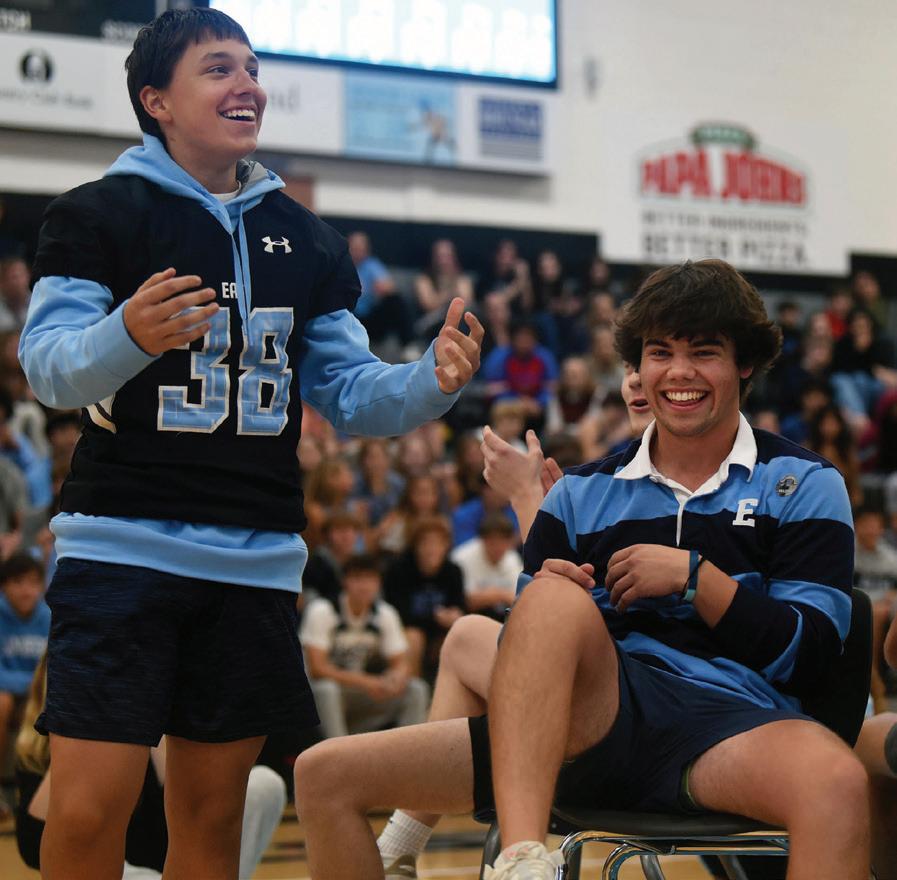
flags to begin the homecoming pep assembly] was more senior-involved,
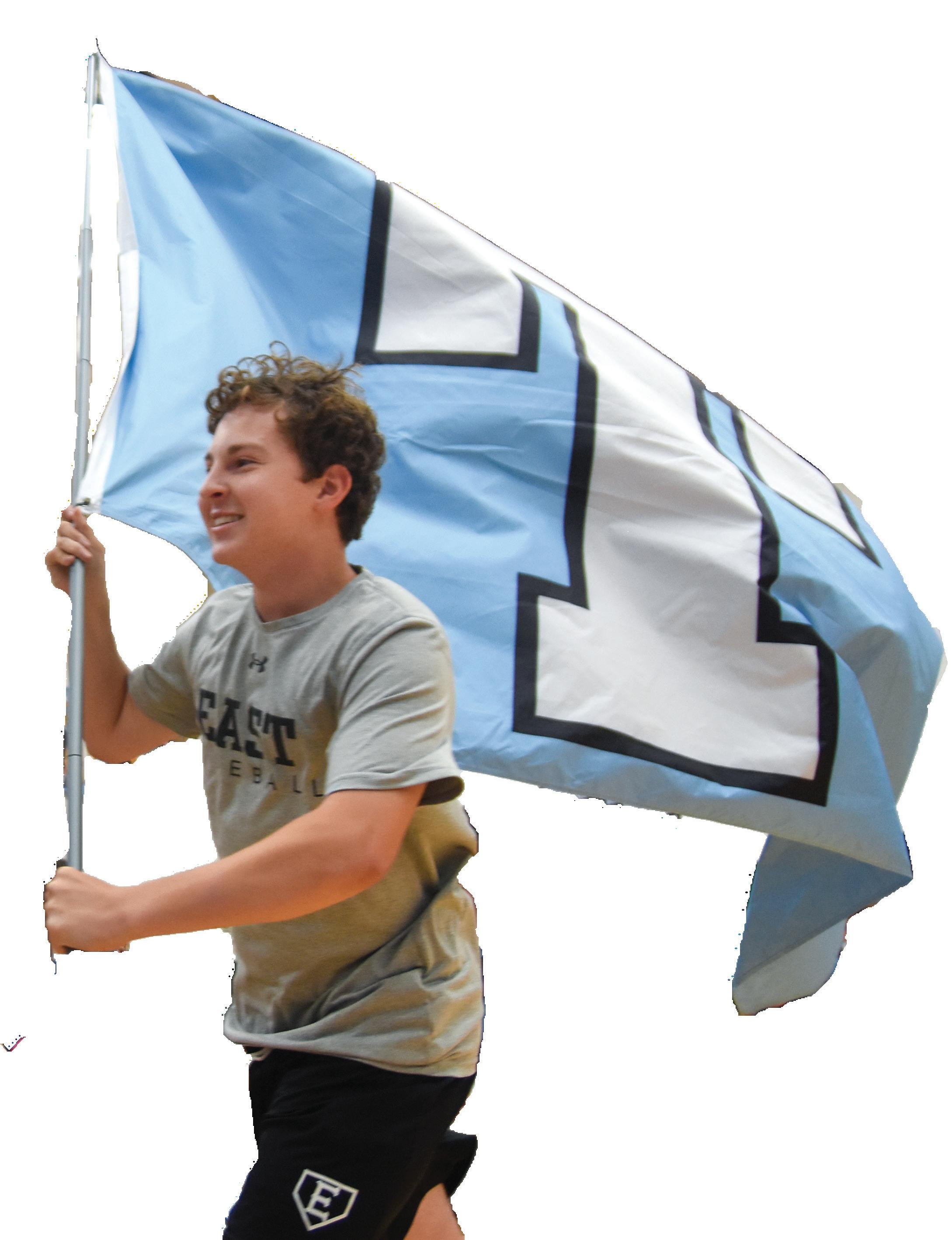 Senior varsity Lancer Dancers Macy Crosser, Adya Burdick and Julie Griggs hit an “L” pom motion during the pom section of their NDA Team Dance. photo by I sabrina dean
SCAN ME PHOTO
Use this QR code to purchase photos from this event
design by macy crosser
Senior varsity Lancer Dancers Macy Crosser, Adya Burdick and Julie Griggs hit an “L” pom motion during the pom section of their NDA Team Dance. photo by I sabrina dean
SCAN ME PHOTO
Use this QR code to purchase photos from this event
design by macy crosser
A look at what’s happening inside East
Students share teachers they feel they trust and can go to with personal issues
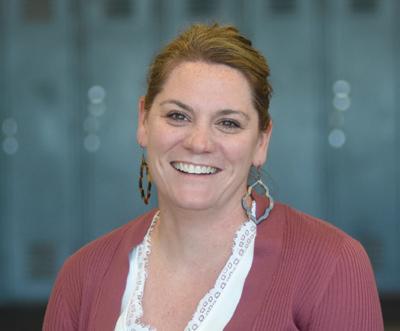
SHE’S ALWAYS there for me, and I love to be able to look at her as both a teacher and a friend. I feel like I can tell her anything.
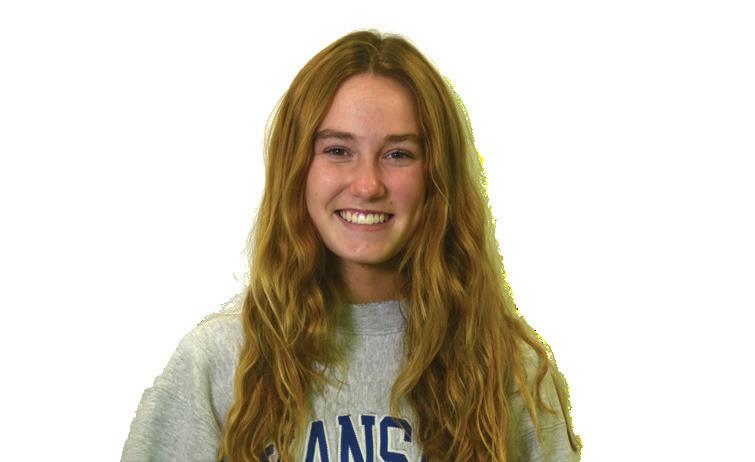


Women’s Choir Chamber’s Choir Choraliers Men’s Choir
TOP Senior Lola Sidie works on her past, present and future project in Ms. Schnakenberg’s painting class. For her project, she chose to paint her bedroom by showing it in the morning, afternoon and evening. photo by I amelie wong


LEFT Junior Wes Lyerly holds the frisbee in relief after chasing it down in a game of ultimate frisbee in team games. photo by I molly miller
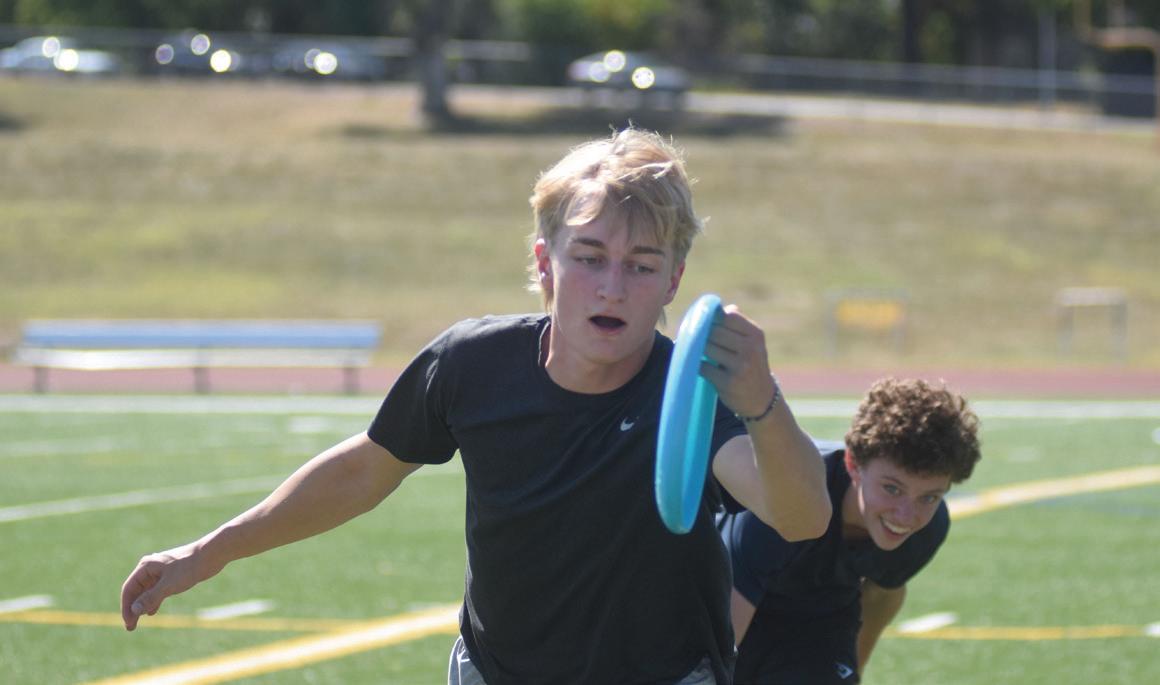
Students share the reasons their parents chose their names

NAMED AFTER “BOO RADLEY” FROM “TO KILL A MOCKINGBIRD,” HER MOM’S FAVORITE BOOK
IF SOMEONE IS having a bad day, he can tell and immediately tries to pick up our spirits. He is super comforting and knows how to make me feel better.
NAMED AFTER HIS GREAT GRANDFATHER, A NUCLEAR SCIENTIST INVOLVED IN THE MANHATTAN PROJECT, WHICH DEVELOPED THE ATOMIC BOMB
NAMED AFTER THE ENGLISH NAME BECAUSE HER LIVED IN ENGLAND FOR FIVE YEARS
East alum Jordan Dunseth reflects on the effect of East tennis on his professional life
AFTER WINNING THE 1996 boys’ tennis state title, then-Eastsenior Jordan Dunseth savored the bittersweet end to his high school tennis career. The feeling of being a part of the best tennis team in Kansas fueled his dream of playing college tennis, but he knew that the next step, pro tennis, wasn’t his future.
Back in 8th grade, Jordan realized his desire to play professional tennis wasn’t realistic because of the tough competition. Now, 30 years later, instead of seeing the sport as a career, Jordan sees it as more of a hobby. Though he still plays adult tournaments, he’s turned his focus to another passion — art.
“[Jordan is] an amazing artist,” Jordan’s sister and 1999 East alum Olivia Dunseth said. “Growing up, he could draw anything. I used to make him draw things for me all the time because I was just fascinated that I could tell him to draw something and he could do it on command.”
Though he didn’t pursue pro tennis, the connections he made on and off the tennis court would impact his life — from high school tennis to his graphic design business, Big Bird Creative, in Corinth Square.
“My dad always said, ‘Remember the names of everyone you meet on the tennis court,’” Jordan said.
After playing tennis at Emporia State and graduating in 2001, Jordan was on the hunt for a graphic design job. Unfortunately, graphic design was in low demand at the time and Jordan struggled to find a job that
stuck. For the next eight years, Jordan had small design jobs but had to mow lawns and do temporary work on the side to earn enough to pay rent.
Then his opportunity arose.
Three-time Kansas state tennis doubles champion and Jordan’s friend from high school Graham Heaven introduced Jordan to the Chief Financial Officer of Tompkins Industries Ben Blades who offered Jordan an advertising job for the company.
After gaining experience with print advertising and designing for Tompkins, Jordan began looking for more business — so he founded Big Bird Creative, his graphic design company now located in Corinth Square. He designs banners, websites, handbooks and infographics for his clients.
“My dad was a creative director growing up and he had his own company so it was something I figured I would always go into,” Jordan said. “East always had really good commercial art and graphic design classes so I took all those classes when I was there.”
A few years after starting Big Bird Creative, former SM West tennis player, Homestead tennis coach and friend Kevin Braun approached him with the idea of illustrating a children’s book that simplified tennis for kids. The book, titled “Tennis for the 10 & Under: The New Look of Tennis From A to Z,” features


pictures of now East tennis players freshman Josie Mangine, junior Veronica Mangine and senior Bryson Langford and was published in October of 2015.
“My coach, Kevin Braun, was the author of the book,” Langford said. “And so I just took pictures for that and it was about tennis advice for younger kids, going through the steps of how to learn tennis and how to be good at it through the alphabet.”
Jordan also designs the website for “The Big Slick,” an annual charity event run by Kansan actors Rob Riggle, Paul Rudd and Jason Sudeikis.
Though he decided to ditch his dream of going pro after college, Jordan’s love for tennis never
really died. In fact, it’s still present in his life just as much as it was when he was younger — just in a different way. Remembering the names of everyone he met on the tennis court — like his dad always told him — is the reason he has his dream job now.
“Every job or career opportunity I’ve ever had can be traced back to tennis somehow,” Jordan said. “Either someone I met on the court playing or someone I met at college because I went there to play tennis.”
who constantly feel like their brains are unraveling, mental health is an everyday conversation. The National Alliance on Mental Illness’s 2022 Mental Illness Awareness Week from Oct. 3 to Oct. 7 provides an opportunity to learn, understand and support those who battle with mental health issues. Each day has a different theme that allows us to look deeper at mental illness’ effect
While Generation Z has been a trailblazer for mental health awareness, shame and misconceptions prevail. From children told to “suck it up” to those raised in open and supportive homes, East students experience a range of opinions regarding emotional distress outside of
Tuesday is themed “Medication.”
Deemed “crazy pills” or “addictive toxins” by critics, anxiolytics, antidepressants and mood stabilizers can be considered an “easy way out.” Others may see not taking them as a sign that an illness isn’t that bad, invalidating a teen’s struggles. There are arguments to medicate and not to medicate — in the end, it’s an individual decision.
Wednesday is called “Therapy.”
Our generation may be more accepting of those struggling internally, but outdated mentalities of addressing illnesses are still deeply woven in our institutions. In therapy, mental health centers and the rest of the American health system, improvements can be made in addressing our struggles.
Thursday is for “Disclosing.”
Ignorance easily blinds us to our peers and personal inner battles. Whether it’s trading sleep for a stacked college application, pumping iron until our bodies snap or seeing a stranger reflected in the mirror, students face unrealistic pressures that are normalized in East’s highly competitive environment. To address and overcome these issues, one must first open their own eyes and seek perspective.
The week ends with “Caregiving.”
In high school, our minds must unravel a bit to wrap around drama, activities, assignments and emotional fluctuations. Each challenge presents opportunities for personal growth and realworld understanding, but students must remind each other to balance excellence with well-being. The same way muscles need rest days, brains need peers and resources to untangle them.


AS SOON AS the doctor left the office, then-sixth-grader Ann Smith* felt her mother’s glare — she knew what that look meant. Smith had done something wrong.
On the car ride home after her mental health screening, Smith felt that she was a little too honest in her answers. She saw it in her mom’s eyes and heard it in the restrained anger in her voice when she asked “Did you even understand his questions?” To Smith’s mom, mental illness was a taboo topic to discuss within the family, much less with her child’s pediatrician, who recommended therapy.
As teenagers like Smith seek open conversations about mental health, conflicts emerge between children and parents who feel less comfortable sharing emotions, leading to strained family relationships and shame around mental illnesses.
feel uncomfortable talking to their parents about mental health, according to an Instagram poll of 181 students. Now-junior Smith is one of them.
That’s why it wasn’t until high school that Smith started consistently seeing a therapist — without her mom’s knowledge.
Former Prairie Village psychologist Sally Pollock, who specialized in a variety of adolescent mental health issues for over 40 years, has seen a generational shift in mental health awareness. Compared to clients she helped at the beginning of her career, young patients were more open to expressing emotions and often better informed on mental health.
PARENTS FEEL uncomfortable with the idea that their child would have mental health issues [be cause to them] it still feels like a faw.
At East, students discuss personal struggles with counselors, teachers and peers in organizations like Sources of Strength, a club intended to promote mental health awareness. Despite the openness in school, 53% of students still
She attributes this increased awareness to social media, a platform for discussion and education that parents lacked as teens. As a result, many parents grew up believing mental health should be dealt with privately, or not at all — and still retain this attitude.
“Parents feel uncomfortable with the idea that their child would have mental health issues [because to them] it still feels like a flaw,” Pollock said.
Judgment and unwillingness to discuss mental health at home can create a strained
relationship between parents and teens, according to Pollock. If a child fears their parents will accuse them of lying about their illness or suggest they “suck it up,” this can lead to resentment and mistrust in families. In therapy, she often saw bottled-up anger often released through yelling, screaming and cussing on both sides.

For Smith, it resulted in a quiet house. She avoids any conversation with her parents now. When her dad gets home from work, she takes long showers to avoid talking. When her mom asks how her day was, she mumbles “fine” before rushing upstairs to her room.
“We live under the same roof, but I’m on my own,” she said.
For some students, opening up is easier when parents make the effort. Talking about mental health with her mom and therapist has dramatically affected how senior Anna Galvin copes with her struggles. She’s grateful to have supportive parents and wishes all families would actively promote open discussions to confront the stigma within homes.
“I know some people are against therapy and don’t believe that it helps them, but therapy has helped me so much with my
mental health and getting everything out,” Galvin said. “If I’m telling my mom or therapist something, it makes me feel so relieved, and a huge weight lifts off my shoulders.”
To have productive conversations with hesitant parents, Pollock recommends that children research their symptoms and ease parents into a discussion. However, for urgent symptoms such as suicidal thoughts, she encourages teens to be direct in seeking support.
In response, parents should emphasize that sharing mental issues is admirable, not shameful, she said. “It’s got to be the adolescents that do the educating of their parents,” Pollock said. “Some parents are wonderful about it and very supportive of their children when they’re struggling with mental health issues. The ones that aren’t, they’re still stuck in that stigma. Gentle sharing of information by adolescents to adults, bringing up mental health occasionally, openness — that’s how you show your parents how to confront mental health stigmas.”
IF I’M TELLING MY mom or therapist something, it makes me feel so relieved and a huge weight lifts off my shoulders.
ANNA GALVIN
As mental health awareness increases through Gen Z, tension ensues between teens and older generations who grew up around a sharper stigmastory by francesca stamati *names changed to protect identity design by francesca stamati photo by nora lynn
STUDENTS LEAVING PRACTICE and clubs at 5 p.m. may not notice senior Michael Newbold slumped for a nap in the reclined seat of his white MercedesBenz.
It’s only on days when he’s been frustrated with too many people, his hands are too jittery and his eyes can’t focus long enough to drive the 6.5 miles home immediately after one of his seven different school club commitments.
They definitely won’t hear the ringing of the 30-minute timer he set because his body naturally wakes him up ten minutes before it goes off anyway. He’s accustomed to “not sleeping much” by his personal standards — meaning an average of three hours of sleep each school night. He’s also used to the brain fog that comes with lack of sleep.
Saint Luke’s Hospital Sleep Disorders Center leader Michael Bajkowski is extremely concerned about students like Newbold for the sake of their overall well-being. He has noticed his teen patients sleeping progressively less over his 32 years of practicing sleep medicine, but he’s worried more now than ever about students’ diminishing sleep schedules.
Sleep deprivation due to evolving societal pressures is a growing issue quietly damaging high schoolers’ mental and physical health. More than 87% of U.S. high schoolers sleep far less than the recommended 10 hours, according to the National Sleep Foundation, a percentage that has been increasing annually in the last five years. Bajkowski attributes this trend to two major societal changes: the increasing competitiveness in schools and the growing popularity of social media.
sleep•apnea a potentially serious sleep disorder in which breathing repeatedly stops and starts
“Lack of sleep doesn’t only affect focus,” Bajkowski said. “It has overwhelming health consequences on memory consolidation, athletic functions, increased levels of anxiety and depression, irritability and lack of motivation that are becoming more obvious as society evolves. Consequences of exhaustion and the coping mechanisms to deal with them are both becoming more extreme.”
At East, 70% of students report experiencing sleep-deprivation that affects their mental health, according to an Instagram poll of 169 students. For Newbold, the negative effect on his mental health stems from overwhelming pressure to excel in academics and extracurriculars.
From Thursday to Saturday two weeks ago, Newbold spent 67 hours writing five college essays, catching up on Calculus homework, brainstorming for the Freelancer magazine, performing with the Color Guard, debating at a tournament, competing with the robotics team and practicing for ROTC.
This left time for only five hours of sleep total over the three-day period — a “generous” estimate by Newbold.

At East — one of the top public high schools in Kansas — Newbold justifies his extreme sleeping habits with his desire to beef up his college application. The number of college applicants during the 2021-2022 cycle rose 21% compared to the year prior according to Common App, so Michael feels he needs to stay up later and be more involved to set himself apart.
“There’s a gap in the understanding of how sleep-deprived young people actually are,” Newbold said. “Adults might not realize, but academia in general is becoming more competitive which forces students to spend more time working to get that edge.”
Newbold made up for his sleep shortage the Saturday night after his three-day stunt two weeks ago by getting “enough” sleep — he considers any amount over five hours to be plenty. That particular stunt wasn’t even that bad in his opinion, since he didn’t reach the point of exhaustion where he loses his appetite. Normally that happens for him after a four-day streak of less than five hours of sleep total.
“My parents occasionally lecture me on how I should get more sleep, but I just can’t help it,” Newbold said. “I tell them that I have a deadline the next day, and I need to get my work done.”
Senior Tyler Kirchhoff’s parents, like Newbold’s, bug him to go to sleep earlier. On top of balancing AP classes and marching band, he was diagnosed with sleep apnea and insomnia three years ago after struggling to focus in class with hyperactive, ADHD-like symptoms — all contributing to his average of 3-6 hours of sleep each night.
Even though his sleep apnea medication doesn’t work well, he drags himself to school no matter how little sleep he got the night before.
His strategy is to eat a good breakfast, but exhaustion still catches up to him on his most tired days. One time, his cream cheese bagel wasn’t enough to prevent him from lashing out on a classmate for not pulling their weight with a statistics project — something that would never happen if he was fully awake.
The short temper that Kirchhoff and other teens experience is a common symptom of sleep deprivation, according to the National Sleep Foundation. But craving sleep doesn’t just make him irritable. His wake-up Cheerios didn’t stop him from drowsily backing his car into his trash can or almost dozing off behind the wheel after school.
“I had driven down Somerset to my house so many times that it was almost muscle memory,” Kirchhoff said. “I felt my head slowly bobbing down as I was driving before I snapped up, thinking, ‘Oh my God.’ I didn’t know how much time had passed.”
Bajkowski warns that students should be concerned if they fall asleep in any calm situation, like driving. It’s their brain’s way of begging for more sleep.
“As long as students are busy, they’re doing great,” Bajkowski said. “But when they’re at a stoplight or catch that idle moment in class, they can easily enter white line hypnosis where they just zone out. Sleepy driving should be seriously avoided.”
Newbold is familiar with the dangers Bajkowski is talking about. The last time he had to nap in the East parking lot was because he knew he’d slipped too far into hypnosis to safely drive the 20-minutes home. Re-parking under the cool shade of a tree in the East parking lot, he shut his eyes for twenty minutes instead.
“I don’t want to say I was hearing things that day, other than a humming noise in the back of my head,” Newbold said. “But what people were saying to me was becoming less and less audible as I was leaving school, and I knew it’d be dangerous if I didn’t nap before driving.”
Bajkowski’s concern is that not everyone is as responsible as Newbold — 66% of East students in an Instagram poll of 250 reported a lack of sleep negatively affecting their driving abilities. Around 21% of fatal car crashes involve a person driving while drowsy, according to the American Academy of Sleep Medicine.
The previously pristine hub-caps of senior Vivian Reihl’s car are now scratched and worn from drowsy curb checks. It’s hard for her to focus on the road en route to 6 a.m. varsity volleyball practices after hours of homework and working two jobs past midnight.
The blasting siren sound of her alarm — the only ringtone blaring enough to stir her — rips through her head at full volume each morning, but she still struggles to get out of bed after her regular five hours of sleep. It’s tempting to snooze for 15 more minutes and ask her mom to call attendance about her “appointment.”
A little too tempting. Last year, she had 87 total excused absences and received a truancy letter during the last three weeks of school. Her mom won’t let it happen again.
“Now I have to physically force myself to sit up and wake up by asking myself, ‘Do you want to be on truancy again this year?’” Reihl said. “I know I can’t get called out anymore, and it’s getting better this
year. But I’m still so tired.”
Attendance receptionist Joan Gustafson noticed a significant increase in the students who regularly come in 15 minutes mystery appointments — suspected — in the past five out of her 17 years in She’s puzzled because this wasn’t an she attended East as part of the class Beyond school commitments, Riehl media as a major reason she stays up a poll of 292 East students, 87% feel like to check their phone right before going This includes sophomore Ron Phyre, gets so foggy from being on his phone that he normally can’t remember what he puts it down. He estimates around 2 or 3 a.m. each school night.
Elongated exposure to blue light from screens in the evening, like that of Phyre’s, is comparable to self-induced insomnia because it suppresses production of melatonin necessary to fall asleep, according to Bajkowski. But Phyre wants to check TikTok, Instagram, BeReal, Twitter and Redditt nightly, since he doesn’t have time during the day when he’s napping or completing assignments. Sometimes he watches shows on Netflix, Hulu and HBO to wind down as well, averaging six hours of sleep each night — equal to his average of six hours spent on social media daily.

“Sometimes I have homework and sometimes I just want to stay up late,” Phyre said. “I’m not in the hardest classes can take, but my homework still takes Then I’ve also got probably ten different shows that I want to and almost have before I go to sleep.”
story by katie murphy
Gustafson has the number of minutes late for oversleepers the position. an issue when of 1980. Riehl cites social up late. Out of like they have going to sleep. whose brain at night what time
Junior Maya Brown* — who averages six hours of sleep — also reports scrolling through her phone in the darkness of her room. She started staying up late after homework and sports practices when she got her first phone in sixth grade and hasn’t stopped since. When she wakes up in the morning, caffeine doesn’t stop her eyelids from feeling heavy or the persistent humming in her chest. She needs something more, and so do the 35 out of 208 East students who admitted to using illegal substances to cope with being tired in an Instagram poll.
High school students who get less than eight hours of sleep per night are significantly more likely to use alcohol, smoke marijuana and become lifetime users of illegal drugs, according to the National Center on Addiction and Substance Abuse. Brown turned to weed to help her wind down at night during her sophomore year — something Bajkowski is strongly against.
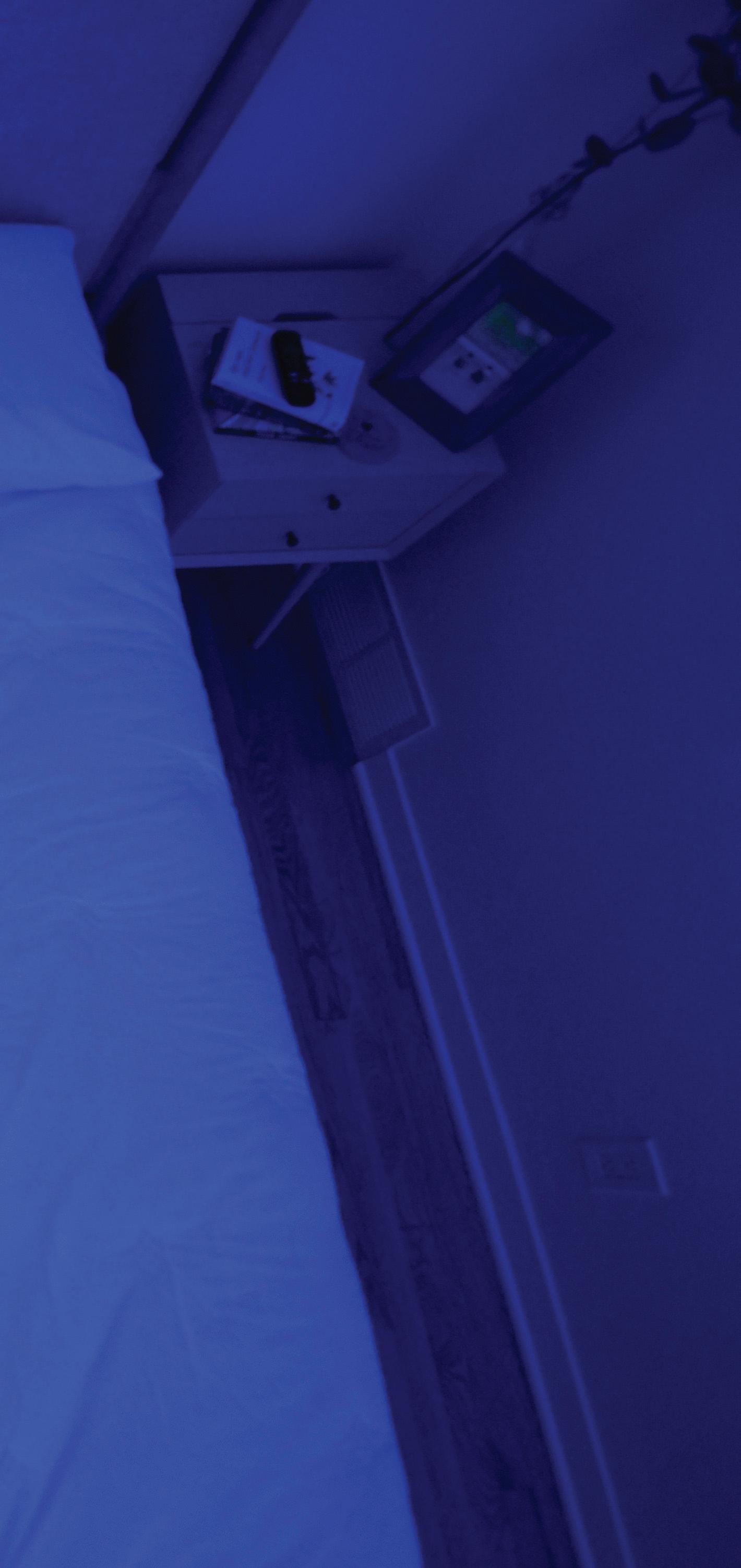
I HAD DRIVEN down Somerset to my house so many times that it was almost muscle memory,” Kirch hoff said. “I felt my head slowly bob bing down as I was driving before I snapped up, think ing, ‘Oh my God.’ I didn’t know how much time had passed.
late,” classes that you takes a long time. different apps and to check out

“Maybe marijuana can make you fall asleep, but it’ll be less quality sleep,” Bajkowski said. “It’s not the solution to being tired, but there will always be people who build their own excuses to use it as a ‘solution.’”
Brown* believes smoking is the main coping mechanism keeping her calm and awake during the school day. That single hit of a cart in her car before heading to first hour makes her feel less shaky. The same hit at night calms her anxiety about school and friends and helps her fall asleep.
“Last year, I made some stupid decisions, like being high in chemistry class,” Brown* said. “Even
when I would throw up in the bathrooms between classes because of smoking, I just feel like it was the one thing that was getting me through the day. Still, I’ve been trying to stop these past few weeks.”
She can only think of one teacher at East who has ever noticed how tired she is in class. Bajkowski believes that schools should seriously reevaluate the physiological needs of students regarding sleep, even if it means moving start times.


“I’d say I’m an extreme case of sleep deprivation,” Brown* said. “But almost all of my friends and the majority of students I know at East are concerningly tired.”
deprivation due to evolving societal pressures is a growing affecting high schoolers’ mental and physical health


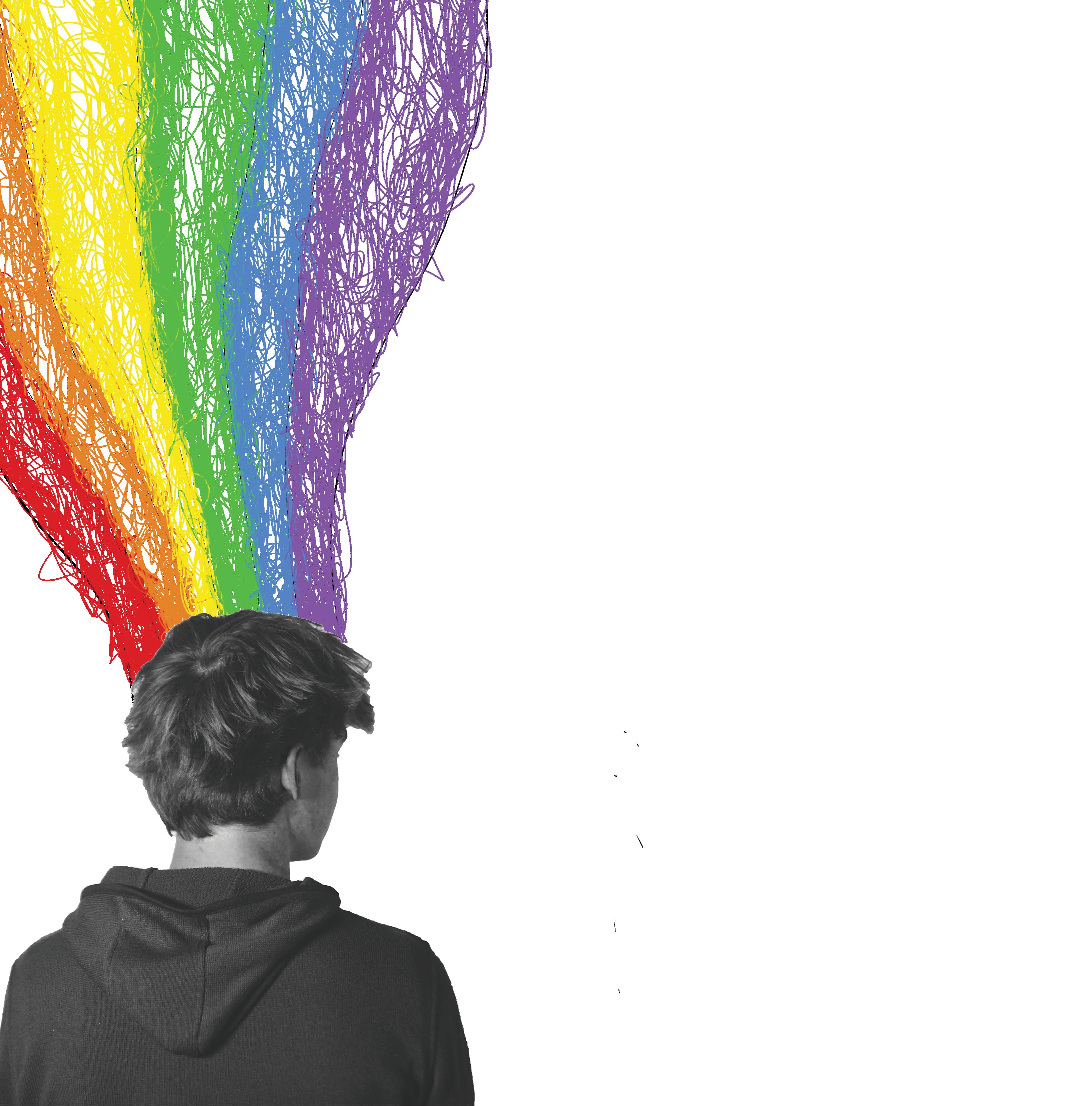




KNOCK. AN OFFICER pounded her knuckles against my bedroom window, which I only half-heard as I scribbled goodbye letters to my mom, dad and little brother. The sound of their banging drifted away with my thoughts.
need for change was clear.
to the Care and Treatment Act, which requires 24/7 surveillance of patients struggling with mental illness. For non-aggressive patients, this feels invasive and unnecessary.
action taken to improve a situation especially a mental disorder
If I tell them to move on without me, they will, right? That will help. Just like the movies. I jumped, hearing the second knock, and forced myself to open the front door. Eyes wide at my shaking arms and tear-streaked face, one of the police officers nudged the other and muttered for him to say something.
“Uh... um... how are you feeling?” he said.
If you’ve ever been in crisis, you know that this is the least helpful, most dreaded question anyone could ask. He knew exactly how I was doing. The purpose of an intervention should be emotional support, not a halfhearted attempt to push aside the call.
It was the first of many flaws I’ve seen firsthand of the American health system. Progressive healthcare and top scientists constantly work to improve physical healthcare, devising vaccines, perfecting surgical techniques and analyzing the human body down to the atom. Unfortunately, this rigor isn’t applied to mental health. While not all is bad, the system desperately needs to be restructured. After spending a week in a psychiatric hospital, the
I saw a 12-year-old girl have a seizure and jerk a neurostimulator implant out of her abdomen just so she could escape the ward, shouting at the nurses as she was escorted to the ambulance waiting for her outside. I’d see the same 16-year-old girl getting restrained twice a day. The 15-year-old brunette girl from across the hall screamed and thrashed when she learned she couldn’t go home. I’d watch the four year-old boy in the cafeteria, sullenly eating his vanilla pudding alone. I saw other child patients scream and thrash as nurses pinned them to the ground, triggering my existing anxiety. For a calm place to recover, this chaotic environment defeated the purpose.
When entering most children’s psychiatric wards, the first step is changing your clothes. The nurse in the room with you takes all personal items — shoes, clothing, phone and jewelry — and has you slowly spin in a circle, squat and cough. All while naked. The procedure is intended to check for cuts, bruises or other possible bodily harm and search for harmful substances or weapons.

Though the intentions are pure, this protocol is humiliating, making myself and others suffering feel more exposed and unsafe than ever. Degrading patients won’t help them to recover effectively.
My first trip to the ER, prior to the psychiatric ward, was just as bad. Though I was physically cared for with heart and stomach monitors, I felt like a caged animal. My mental struggles made me a threat. I felt crushingly alone, despite the nurse assigned to stay in my room at all times. My door gaped open at all times due
Nurses and doctors probed me with insensitive questions — even assuming I had tried to kill myself for attention. It was clear to me that training of healthcare professionals doesn’t include effective tactics to handle mental health crises.
Child healthcare professionals are currently only required to complete nursing school, learning primary health care. According to The National Center for Biotechnology Information, there is little evidence proving that this curriculum prepares nurses in crisis intervention.
Information, there is little evidence proving that this curriculum prepares nurses in crisis intervention.
Reflecting on my 13 year-old self, I deserved to be cared for and seen, rather than feeling forced to mature in order to make the lives of the nurses and officers easier. Patients in psychiatric wards deserve to be invested in not only emotionally, by best preparing staff who will help them. Mental healthcare should leave patients less traumatized and more emotionally stable. In the current health system with the existing procedures, patients are prone to excessive stress within the supposed solution. By education faculty within law enforcement and healthcare providers, we can ensure that no other child will have to endure the trauma that I was unknowingly exposed to.
design by peyton moore art by nora lynnThe American mental healthcare system should focus more on empathetic rehabilitation
FRESHMAN AIDEN COX went days without getting out of bed or brushing his teeth, objects strewn around his room after a depressioninduced psychosis. Sophomore Ainsley Pyle described herself as a “ball of anxiety,” unable to function in daily life. Junior Emma Kuhlman knew she’d reached her tipping point when she could no longer hang out with friends without her self-conscious thoughts taking control.
the reabsorption by a neuron of a neurotransmitter following the transmission of a nerve impulse acrosse a synapse9

The prescription of a pill changed the course of their lives.
Since Cox’s doctor prescribed a daily dose of Fluoxetine, Hydroxyzine and Olanzapine, he’s able to brush his teeth and get to school nearly every day. Pyle has gotten out of her comfort zone and found new passions like aerial silks. Kuhlman often feels more extroverted than she ever had before.
When it comes to treating mental illness, there are several options for medicinal treatments. Most medications work by blocking serotonin reuptake, and with less of this mood-regulating hormone passing messages between nerve cells, users experience a more stable mood. SSRIs and SNRIs are the most commonly prescribed types of these medications.
But not everyone has medication success stories. This is why board certified psychiatrist Dr. Christopher Van Horn, who has specialized in child and adolescent psychiatry for 20 years, says that medication for mental health issues should be reserved as a last resort in most cases. Because of
art by nora lynnpotential side effects, adverse reactions from person to person and the lifestyle changes that need to be made before taking them, Van Horn recommends careful consideration of these factors before requesting a prescription.
For students like senior Bella Lynch, it takes months or even years of trial and error to find the right medication. After seven years of battling severe anxiety and four years of therapy, nothing was resolving Lynch’s constant state of panic, so she turned to medication as a last resort. Her pediatrician prescribed Sertraline — commonly known as Zoloft — which came with a slew of unbearable side effects: dizzy spells, nausea and panic attacks even worse than before the medication.
After two months, she couldn’t take it anymore — she switched to Fluoxetine, or ProZac, which has since changed her life. Though Lynch still deals with daily stressors and anxiety-inducing situations, whether a presentation in English class or uncomfortable social interaction, the combination of her medication and coping skills from working with a therapist allow her to push through these moments instead of shutting down.
“It changed the way that I approached situations and allowed me the chance to set myself in the right direction,” Lynch said. “It gives me that extra something to get through the day, and that’s something that I didn’t know if I’d ever be able to have. It really has impacted my life and allowed me to actually do things and not feel so sick all the time.”
The choice of which kind of medication, or whether to even medicate at all, depends on a number of factors that vary by mental illness. For example, those with mild to moderate depression won’t respond to SSRIs, while someone with severe symptoms like
story by lyda cosgrove Students and a psychiatrist weigh pros and cons of medicating mental illnesses and its surrounding stigma
suicidal ideations or hallucinations would likely be co-administered a combination of medication and psychotherapy according to Van Horn.
With generalized anxiety disorders, psychotherapy should always be the initial intervention, according to Van Horn. It’s when a patient is clearly not responding to that intervention that they should consider medication, but only after the entire situation has been examined.
“ You have to know what you’re treating first,” Van Horn said. “If you don’t have a good idea of what a person’s condition is, you can’t appropriately treat it.”
From her experience, Lynch agrees that medication is not the quick-fix or cure as it’s often perceived to be. While antidepressants don’t eliminate underlying causes of mental illness like an antibiotic would quickly cure an infection, they instead alter neurotransmitter levels and functions in the brain over time, without permanently changing brain structure or chemistry. And according to Van Horn, medication is only ever effective when in combination with adequate sleep, medical care, regular physical activity, sunlight exposure and a healthy diet.
“Medicines don’t work in a vacuum,” Van Horn said. “For example, if I’m taking Zoloft and I’m continuing to smoke pot three times a week, and drink alcohol on the weekends, I’m probably not going to respond to an antidepressant if I’m loading my body up with depressants, so there’s some lifestyle issues that need to be taken into account.”
Through years of openly discussing anxiety, depression and medication with peers, Pyle, Lynch and Kuhlman have grown familiar with criticism around to how, when or why someone medicates. For example, those who choose to medicate are often confronted
with alternatives and blamed for taking “the easy way out,” according to Lynch.
Kuhlman’s been told to simply try journaling and Pyle’s been told to take more deep breaths. Van Horn acknowledges that these solutions can be helpful in moments of panic or stress for any person, but not for those with chronic anxiety disorders where medication is often vital to their daily functions.
Some choose to avoid medication. But those who overcome struggles with natural approaches like CBD or herbal remedies, breathing exercises and coping skills are seen as invalid or that their struggles must “not be as bad” if they can handle it without the aid of medication.
“No matter what you do, somebody’s gonna have an issue with it,” Pyle said. “You either don’t take medicine and people are like, ‘It’s not real, you’re not taking medication for it, therefore it’s obviously not bad enough.’ Or you do take medication and people are like, ‘Well, so you didn’t try anything else. Your only fix to this is taking medicine?’ They think the first thing that we jumped to was like, ‘Yeah, let’s just pump her full of medicine and that’ll fix the problem.’”
Van Horn believes that the critical stigma around medication taints the way people with mental illnesses approach treatment compared to how they would approach non-mental-health-related prescriptions or medical treatments, like glasses and contacts or asthma medications.
“This has a lot more weight than that. People usually don’t think twice about taking their asthma medications and there are some people out there who really, really need to be on psychiatric medication,” Van Horn said. “And the stigma prevents them from being able to consistently do that.”
THE HARBINGER design by peyton mooreWOMEN are more likely to take medication for mental health than men
of U.S. adults take perscription medication for mental health
Of people take medica tions for mental health
to nmih.gov
FOR JUNIOR EMALINE Handzel, mental health struggles from sports looked like uncontrollably crying on her drive back from volleyball practice three times a week for two months straight. For sophomore Morgan Anderson, it looked like constantly and obsessively comparing her abilities and scores to the other girls at dance team tryouts. For junior Ayden Beveridge-Calvin, it looked like mental burnout on a sport he used to love because of his coaches’ constant negativity.
These current and former student athletes — along with 130 others at East — report their mental health suffering at some point due to sports. Whether it’s pressure from coaches, anxiety before games or depression following injury, sports-induced mental struggles are prevalent among today’s youth.
become unmanageable on top of homework, extracurriculars and social interactions.
Former East social worker Becky Wiseman, who is a clinically licensed social worker specializing in sports medicine, has seen many cases of perfectionism and anxiety while working at East, Children’s Mercy and Sporting KC for the last 18 years.
“Typically, I’m working with a lot of really high-performing individuals, people who want to do well in every area of their lives,” Wiseman said. “They push themselves really hard. And not only in sports, but also in their classes and socially.”
brought to light by the suicides of three college athletes in the past year — soccer player Katie Meyer, cross country and track runner Sarah Schulze and softball player Lauren Bernett — depression is common among student athletes according to ACHA, even if it isn’t widely discussed.
Black isn’t alone. In an Instagram poll of 131 East student athletes, 61% say that they’ve felt depressed after not being able to play a sport, usually due to injury.
In a poll conducted by the American College Health Association, 30% of 195,000 collegiate student athletes surveyed reported having felt depressed in the last year. In the same period, 50% reported overwhelming anxiety. One main cause is the pressure to perform at a high athletic level, according to the ACHA. Pressure can come from parents,
This anxiety manifests itself differently in different people. For dancer and senior Ava Black, it was feeling physically sick to her stomach before preformances, nausea and knots forming.
“It’s definitely made my anxiety a lot worse,” Black said. “This past summer, I had dance nationals and I was so incredibly stressed for it that I would make myself feel super sick.”
Along with anxiety about sports performance, depression is the second most prevalent mental illness reported by
In many cases, conditions like depression and anxiety in student athletes stem from not being able to play a sport, usually while injured or during offseason. Wiseman points out that it’s difficult to cope with mental illness when an athlete’s coping mechanisms are intertwined with their sport. For example, she says when running cross country or playing soccer after school is how you unwind after a long day and process your emotions, it’s hard to replicate that without being able to do this activity.
Black’s dependence on dance motivates her to continue training despite its toll on her mental health. Worrying about her ability compared to the other girls in her studio on top of balancing hours of homework from her AP classes and her work schedule made her feel burnt out, but she continued to do it because she says dance is “a piece of her.”
“[Dance has] made me really upset, and I’ve wanted to quit a lot because it’s just so stressful, and it’s caused me so much anxiety,” Black said. “But dance is who I am. When people think of me, they’re like, ‘Oh



For student athletes struggling with depression and anxiety, Wiseman recommends setting aside time specifically reserved for relaxation. This, she says, is the difference between feeling victimized and empowered by a busy athletic schedule.
“An athlete’s depression can be just as debilitating as anyone else’s,” Wiseman said.
“The difference is that sometimes, they just don’t have the time or bandwidth to take a look at it until things slow down.”
More conversations surrounding the subject of athletes’ mental health are coming to light, including gymnast Simone Biles’s decision to not perform in the Olympics and swimmer Michael Phelps discussing his depression. Wiseman hopes these conversations transfer to high schoolers to normalize athletes asking for help.
“We’re having a discussion, which to me, is so helpful because that’s really important, saying ‘I don’t want to sit here in shame, quietly suffering and not letting anyone know what’s going on,’” Wiseman said. “So I think athletes coming forward and saying, ‘This is something I experienced, and this is really difficult at times,’ is huge.”
FORMER EAST SOCIAL WORKER
AN ATHLETE’S depression can be just as debilitating as anyone else’s. The difference is that sometimes, they just don’t have the time or bandwidth to take a look at it until things slow down.IT’S GONNA BE LCSW Becky Wiseman’s recommendations for dealing with anxiety as a student athlete RECOGNIZE THE EMOTIONAL RESPONSE TO PUSHING ONESELF AT A HIGHER LEVEL YOUR MINDSET FROM FEELING VICTIMIZED BY SELF-EXPECTATIONS TO FEELING EMPOWERED BY THEM MAKE TIME FOR DOWNTIME; SET ASIDE TIME SPECIFICALLY DESIGNATED TO RELAX AWAY FROM YOUR SPORT ACCEPT & UNDERSTAND THAT HIGH EXPECTATIONS COME WITH CONCRETE ACTIONS TO MAKE GOALS MANAGEABLE
I’d say the animals in my life. I love taking care of them and just being there. And I love being there for my friends, they’re my closest people in my life and I love them so much. So I’m defnitely very passionate about making sure they’re OK and, if they need any thing, they tell me. It feels like my purpose to make sure that people are OK all the time.

My mom did it in high school and college and she was really good. She was like, ‘You should try.’ My mom rowed for the same team. She had the exact same coach that I have now. She wanted me to be involved with that coach, because we loved her so much. I wish we practiced more, but it’s just Thursdays and Saturdays. I’m kinda all over the place [in the boat], but I like sitting in the back, where you row backwards, beacuse it’s a weird position. You don’t see where you’re going.
This is gonna sound super weird, but aliens, because nobody can tell me we have so many differ ent solar systems and like uni verses and there’s no way there’s not another being on a different planet.



Since I was little, I’ve always been in love with being with animals all the time: people’s dogs and their cats and their pets and stuff. We did go to the zoo a lot when I was lit tle, because I was constant ly begging, like ‘We should go to the zoo.’ I always loved the polar bears, watching them spin around. Same with the otters. I remember going to see them.

Spiders, defnitely spiders. I had one in my house in the bathroom the other day. I was about to wash my face, and I saw it, and I stood there for 30 minutes trying to fgure out what to do with it. So I ended up waking my mom up from her sleep and telling her to kill it.
LOCAL
Scan the QR code or go to harbiephoto.com to view and purchase photos of student life and sports





When all you need to do is scream, here are some recommended songs to get your emotions flowing

FRIENDS* by mob rich & bishop briggs

FREAKIN’ OUT ON THE INTERSTATE by briston maroney

BEACHBOY by mccafferty

SHAKE IT OFF by forence + the machine


MONDAY by the regrettes
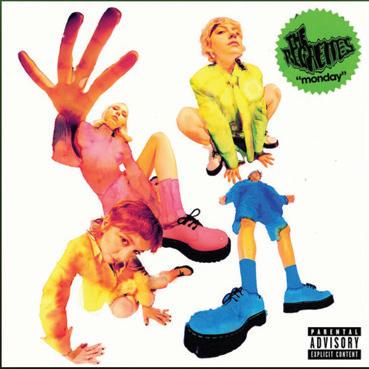
I LOVE HUE a color puzzle game





When you need to stay calm, here are accessible apps to help
1000+ picture
for sleep &
You might have anxiety tics and think it’s just you, but you’re not alone cartoon by sofia blades
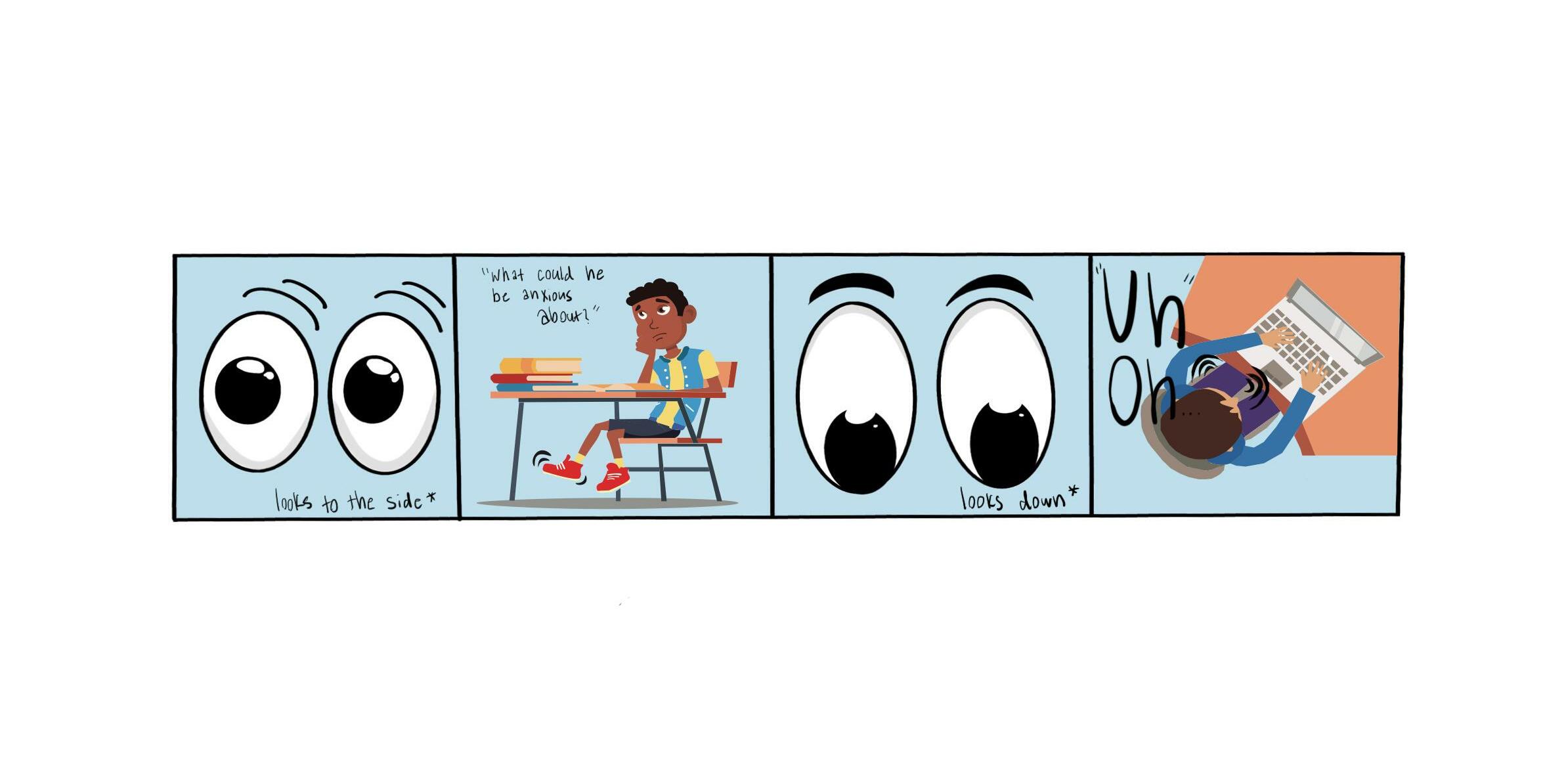
we’ll get some dinner — I’m thinking Thai food — then we’ll go see a band, afterwards we’ll just chill on the couch and to wrap up the night we’ll go get some boba tea.
I know what you’re thinking — she’s about to drain her gas tank. Usually, in order to execute this plan, I’d be driving all over town, but thanks to the Iron District, these activities are conveniently arranged ten steps away from one another so that every craving can be satisfied in one place.
The Iron District is an outdoor food court and retail destination made up of repurposed shipping containers that businesses convert to store fronts. Thursday through Sunday, customers roam between containers, ordering at the windows — a similar concept to food trucks congregating in a parking lot, except most businesses stick around for at least a couple months.
The District is located just five minutes north of Downtown KC — distinguishable by the turquoise, graffitied shipping container standing tall at the entrance. Since opening in the fall of 2020, the Iron District has become a unique hub for weekend fun.
The vendors are the epitome of efficiency. They streamline the ordering process by texting customers when their orders are
ready, preventing customers from crowding around the shipping container while waiting for their order. It’s an impressive level of organization to the generally busy and chaotic ordering process.
Though the Iron District’s hours and days are limited, they pack them full of activities: trivia night every Thursday at 7 p.m., Happy Hour Thursdays and Fridays from 3 to 6 p.m. and live music every Friday and Saturday.
There are giant board games in the courtyard such as Jenga, corn hole and dominoes to keep customers entertained, and it’s pet friendly, being outdoors.
The Iron District provides a space for small, local restaurants regardless of whether they have an established, independent storefront. Their current vendors include Thaiger, Bruu, Taco Tank, Tupelo Joes and Vegan Crave, with menus ranging from boba to burgers. I’d never heard of most of these restaurants before going, but now that they’re on my radar I’ve got an itinerary of new restaurants to try out.
However, these vendors aren’t permanent. The shipping containers are rebranded regularly as new businesses move in. This vender variety offers a convenience factor unmatched by other dining establishments — ideal for plant-based folks who refuse to




compromise with their carnivorous tablemates. While I opted for spring rolls, my companions were in the mood for tacos, and no one had to make concessions.
The seating spans from benches to couches, accounting for intimate meals as well as family-style dinners. The mish-mosh seating, varying shaded coverage and semi-square shipping container arrangement combine to achieve a surprising functue and functionality for the space. It’s full without being crowded.
The Iron District offers shopping as well as dining. Local boutiques such as Boheme, Layne Boutique, Madhouse Clothing, Collections by J and Say It! KC all currently occupy shipping containers there, with various pop-up shops on Saturdays. Although I didn’t make any purchases, the retail therapy was a necessary escape during my hectic week.
The only downside is that it’s a half-hour drive from Prairie Village, but as a result the parking is a breeze since the neighborhood isn’t too busy, especially on weekday afternoons. It’s a great opportunity for us Overland Park folks to expand our bubble.
Overall, the Iron District is an elevated spin on the street food and shopping experience.
 design by lily simmons photo by audrey condon
design by lily simmons photo by audrey condon
 story by paige zadoo
story by paige zadoo
Creating do-it-yourself duo Halloween costumes with pre-owned clothes or easily bought items


To find a classic and easy-to-recreate duo costume, the iconic partner costume, Dr. Seuss’s Thing One and Two immediately springs to mind. We wanted to achieve the quintessential “Cat in the Hat” character’s look with their red, white and blue outfits.
We didn’t even need to do any research to create this well-known outfit — it was practically effortless.
All you need is a plain red t-shirt and construction paper to make the Thing 1 and 2 signs. I wore blue leggings as an optional touch. To save ourselves a trip to Savers, Anna and I turned our red Chiefs shirts inside out.
The construction paper just takes a quick run to Target where you can get a pack of 240 sheets in 12 different colors for just $5.39. This costume should be on the top of your list for an effortless duo look.

HARBINGER design by anna mitchell photos by charlotte emley
A NOTHER CLASSIC, BUT more unique duo that Anna and I obsessed over as kids was Wanda and Cosmo from Nickelodeon’s “The Fairly OddParents.” If you didn’t have the pleasure of watching these two fairies grant Timmy Turner his wishes, you seriously missed out.
Their go to colors are bright greens for Cosmo and electric pinks for Wanda — with the accessories of wands and crowns. You may be familiar with infamous memes that say when young people see
pink and green together, they immediately think of Wanda and Cosmo, so you don’t have to copy their exact outfits, you just have to get their colors down.

I found my brightest pink workout set — a color not hard to find in my closet — and Anna found a green top and sweatshirt to wrap around her neck and paired it with black leggings. The wands and crowns can be a piece of cake too — all you would need is construction paper or another click on Amazon.
Effortless, amusing and affordable: all you could ask for in your next Halloween duo costume.



AS A LITTLE kid, my friends and I spent hours obsessing over Disney Channel’s sitcom “The Suite Life of Zach and Cody.” The twins’ outfits were their trademark feature — a sweater vest or polo for preppy Cody and an oversized tee or Hawaiian shirt for laid back Zach.

So when we were talking about trouble-free but amusing duos, Disney’s favorite twins practically jumped at us; especially because Anna portrays Zach’s outgoing personality and I relate more to Cody’s OCD lifestyle. Not only did we love their relationship but
NOW THIS DUO is practically timeless, with mentions of their pairing going back for more than hundreds of years. Devil and Angel is a household duo that everyone knows.
Therefore, this duo was a must on our list of costumes. We knew we needed to rally red or black and white outfits and couldn’t forget to include horns, wings and a halo. Luckily with the beauty of Amazon, that was troublefree and cheap to obtain.
I wore an all white tennis
also their well known — and a piece of cake to recreate — outfits.
We put together our costumes in less than two hours. Borrowing khaki shorts from a friend, I wore my own polo and Anna wore a Hawaiian shirt she already had in her costume drawer. The only thing we were missing were blonde wigs which were easily found on Amazon ranging from $9 to 12.
Not only was this costume quick to put together and comfortable but it was completely free which made it more appealing. If you’re looking to spark nostalgia in your friend group, this costume is for you.
dress that reminded me of what an angel would wear — flowy and unembellished — with a halo and wings I Amazon Primed for $9.59. Anna wore a black top and black leggings with sparkly red horns also Amazon Primed for $6.99.
This costume was simple as can be, as the only things we didn’t already own were the halo, wings, and horns. Our accessories brought the outfits together for the low price of $16.58.
So if you’re looking for a duo to do with a friend, or even better a frenemy, Devil and Angel is the perfect costume for you.


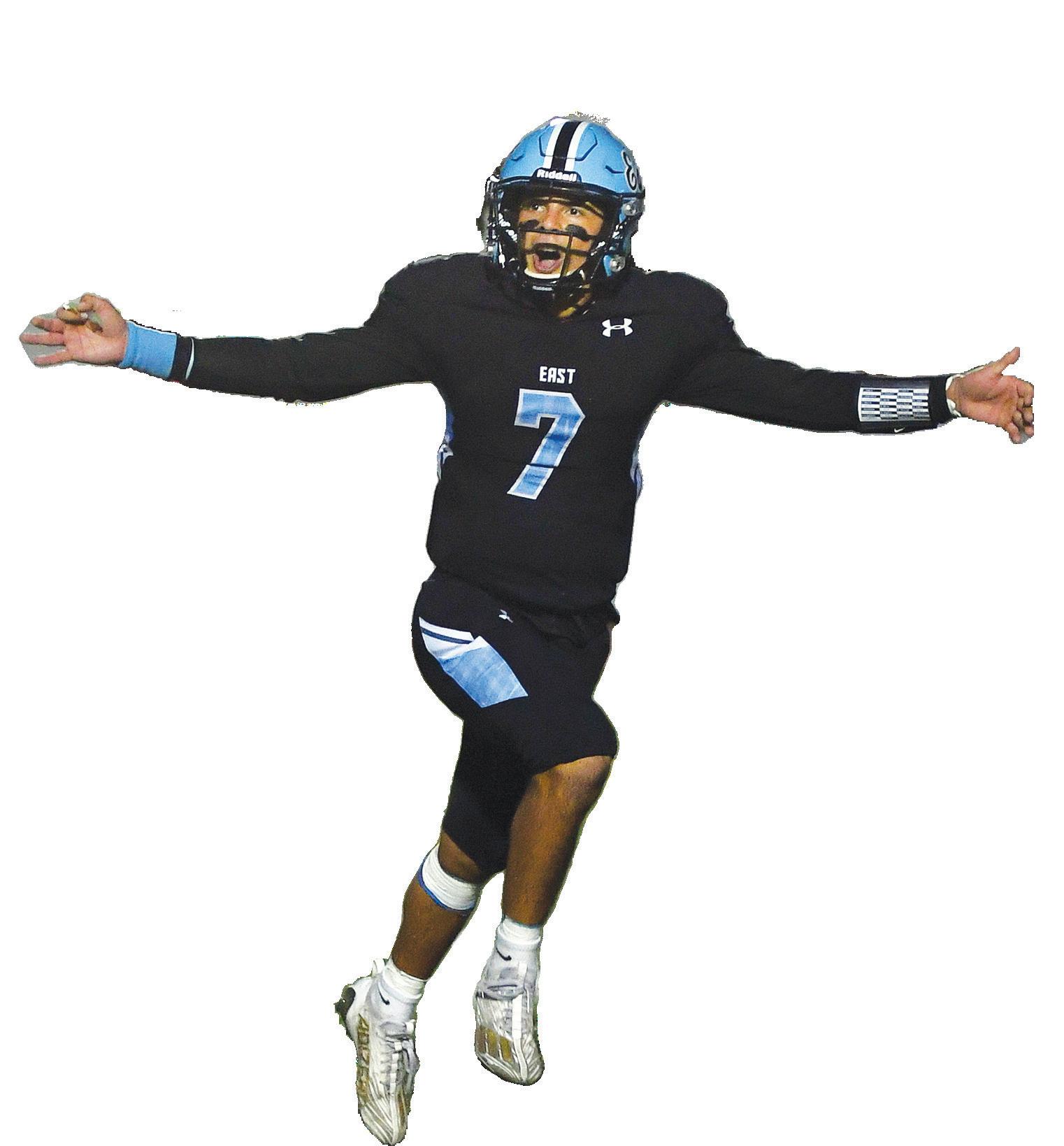

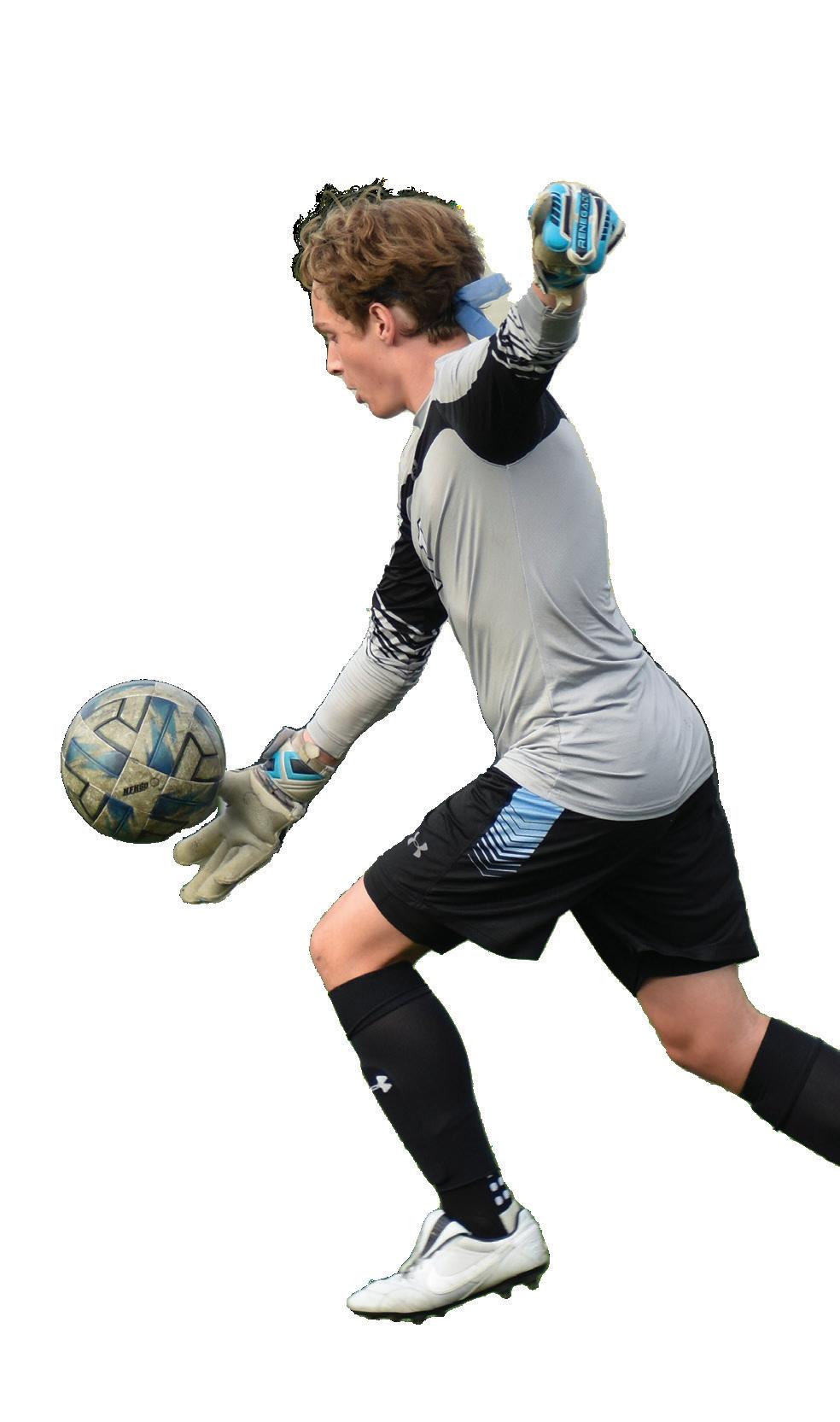 photo by alex sajna
photo by mj wolf photo by charlotte emley photo by amelie wong
photo by alex sajna
photo by mj wolf photo by charlotte emley photo by amelie wong
CROSS-COUNTRY RUNNERS know exactly what to expect when the season begins: stretching calves before a fivemile run, elevating their legs above their head after running to reduce inflammation — and Milk Mondays. Creative traditions are integral to the training methods of cross country head coach Tricia Beaham.
One of the first traditions she started was “The Button Run” — a roughly six mile course around Prairie Village where Beaham distributes buttons across streets for runners to pick up once a year. She forms two paths in opposite directions for the different running levels so everyone has an opportunity to get buttons. The runner who collects the most buttons gets a gift card.
Weekly traditions like Milk Mondays and Popsicle Wednesdays are also rewards for runners after long runs. On Milk Mondays, Beaham gives runners chocolate milk as a source of quick energy after 10-mile-runs.
Parents donate popsicles on Wednesdays for the same reason.
But it’s the Friday night carbo-load dinners that are the fan favorite among runners, according to senior Scarlett Pearlman. To store energy before Saturday
meets, each grade level brings foods like pasta and bread to feast at a senior runner’s house. After eating, the team plays a game of football, basketball or whatever they’re in the mood for.
The dinner isn’t just to fill up on calories — it’s to bond with teammates in different grades. According to senior Blair Ptacek, it works.
“There are people [on the team] that I wouldn’t normally hang around,” Ptacek said. “But the carbo-loads and other cross country events have helped me interact with new people and become really good friends with them.”
Boy and girl runners have separate pre-meet traditions on Friday afternoon runs.
going on and get any advice they need.”
The boys’ pre-meet ritual is kept secret from the rest of the team and coaches due to its “sacredness,” according to Ptacek. It had existed for years as a rite of passage for new runners.
SOMETIMES IT CAN be a little bit stressful having to run a lot and sometimes it’s not that great. So it’s fun to have carbo loads or any times we get together.
SCARLETT PEARLMANGirls sprint down to the boar sculpture in the Village where they touch the nose for good luck. Then they all huddle up and the seniors give a pep talk to the underclassman with tips about the races.
SENIOR“It’s been around for so long and what makes it special is we have it to ourselves,” Ptacek said.
Pearlman and Ptacek agree that experiencing these traditions as seniors has changed because now they’re the ones who are giving advice and helping runners instead of asking the questions.
“Having that pre-meet run is good because we’ve got people who have quite a bit of experience and then also some kids that are just running for the first time,”
“As seniors, it gives us the chance to give all of our knowledge about courses and advice to the other runners,” Ptacek said. “I’ve answered questions that they have like what to eat before meets or what types of shoes they need.”


These traditions have impacted the runners and team as a whole on a personal
level because of the amount of time spent together at practices and outside events.
“I feel like the traditions help the whole attitude of the team,” Ptacek said. “I know for sure everybody on the guys’ side are all super close friends, so if somebody has a bad race or something, we’re not going to hold it against them. Or if somebody that’s typically slower than you comes up and beats you, there’s not going to be a fight because we are all just close friends outside of running because of team dinners and bonding.”
Pearlman commented on the fact that it’s good to have all these outside events with the team because then everyone can be around others who are experiencing the same things.
“Sometimes it can be a little bit stressful having to run a lot and sometimes it’s not that great,” Pearlman said. “So it’s fun to have carbo loads [and spend time] together.”
Some of the teams favorite butmilk
Runners pick up buttons laid out on their race course and the runner with the most wins a prize
their monday run, parents provide runners with chocolate milkSCAN ME GALLERY
Friday before their meet, the team feasts on spaghetti, bread and watermelon
Over the years, traditions celebrated by the cross-country teams have become just as important as the sport itselfphoto by alex sajna
Freshman Brock Rider and fifth-grader Eddie Condon run up and down the sidelines as East’s varsity football ball boys
WITH 23.4 SECONDS left in the first quarter of the East vs. North Varsity football game, freshman Brock Rider and ten-year-old Eddie Condon felt the rush of a touchdown as they raced down the field — or, parallel to it.

Their position isn’t on the field. As East’s official ball boys, retrieving the football from behind the goalpost is just another game for Rider and “Big Ed” Condon — brother of senior Audrey Condon and sophomore Rachel Condon.
Rider’s been running down the sidelines for years. Between playing football in first grade, helping by throwing in footballs on the sidelines of the team his dad coaches and collecting balls for East since 2015 after being offered the job by then-headcoach Dustin Delaney, Rider is familiar with the sound of roaring fans and the gleam of Friday night lights.
“I just really love football,” Rider said. “I’ve been around the atmosphere for so long, that [football] really is my entire life.”
Through Rider’s years as a ball boy cycling through different groups of high school players, he’s grown close with the players — it’s as if he was another member
of the team, he said.
Rider’s father has coached football long before coming to East, starting at Bishop Miege then moving to a small high school in Riverton, Kansas, being the head coach. He’s been around the sport for as long as he can remember, it’s one of the biggest parts of his life.
“I get to experience moments with the team, whether it’s the games, on the sidelines or in the locker room,’’ Rider said. “They don’t care that I’m a freshman, [the players] treat me the same as they would their teammates or any other player.”
The football players have always been a kind of “big brother” to Rider, paying attention and talking to him even when he first started at eight-years-old. Even though he was always many years younger, the players were always trying to have him involved in some way talking to him or including him in team conversations.
Since Rider is approaching his turn to play for East next year, not on the freshman team, his duties as of Lancer Day — September 16 — have recently been shared with Condon, who will eventually take over the position.
Like Rider, Condon has a background in football and is the quarterback for St.

Anne’s flag football team, the Tigers. He’s befriended head coach Justin Hoover over his two years on the team, as Condon’s dad is good friends with Hoover, who later then approached Condon in April offering him a ball boy position for the upcoming season.
On the field, Brock and Eddie’s duties consist of bringing the quarterback and kicker the specific footballs that they want and retrieving the footballs when needed.
Rider assists by telling Condon the perfect times to throw footballs in and when to throw them to the refs during games. Even though Condon is 4 years younger than Rider, nothing stands in the way of their relationship due to Rider’s talent of teaching and helping kids younger than himself.


nickname — have helped Condon get in the groove of being a ball boy by showing him the ropes and how to stay out of the way on the sidelines.
Last season and in occasional years prior, Muller was a ball boy, too. He uses his experiences to mentor Condon.
[almost the same] moments with the team whether it’s the games, on the sidelines or in the locker room. They don’t care that I’m a freshman, [the players] treat me the same as they would their teammates or any other player.
“[Rider’s] a great person to have Eddie around,’’ junior and football manager Michael Muller said. “Brock is great with kids and is probably the most perfect person and teacher for Eddie to follow around.”
BROCK RIDER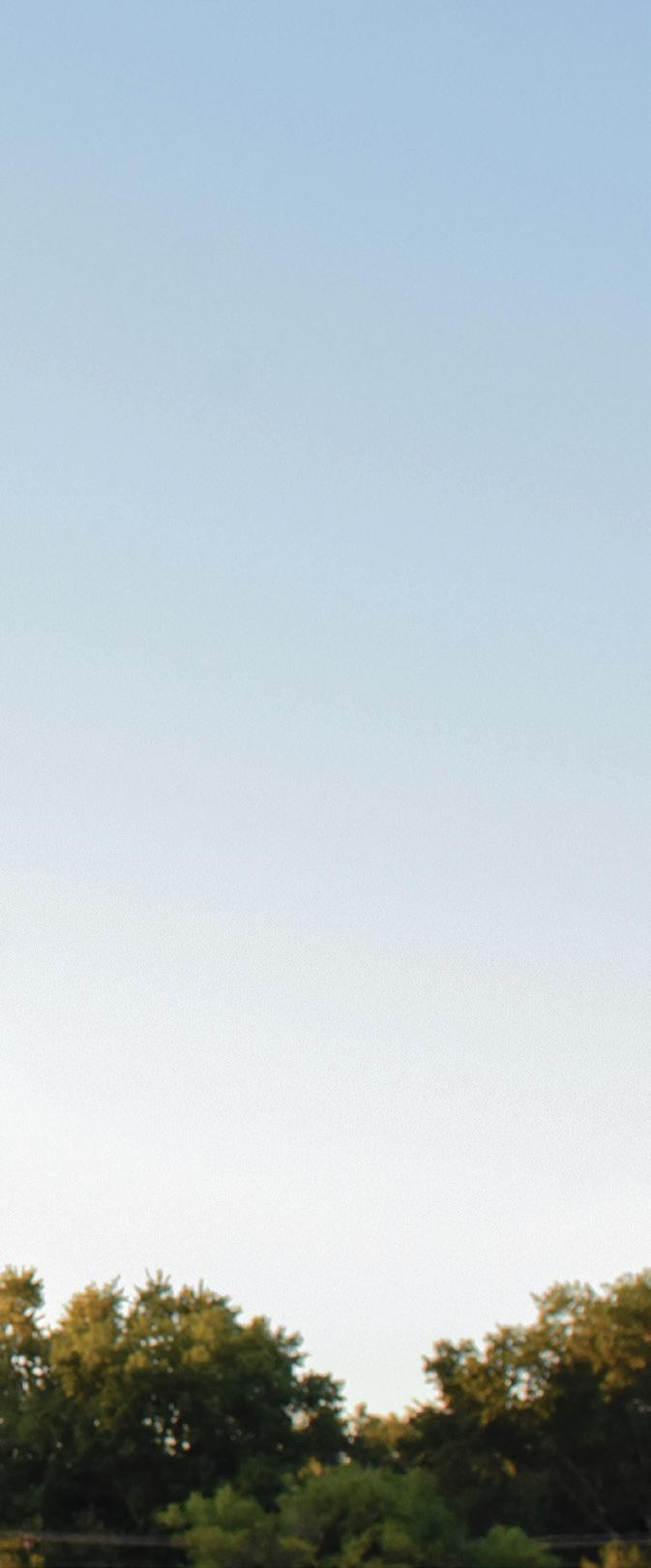
Muller mainly helps Condon get the reins when he is on the sidelines. He helps Condon look out for certain things like where he should be standing or where he should be moving so he doesn’t get in the way all the time. With Muller’s previous years of ball boy experience, he knows refs can be very picky and a little harsh at times, so Muller guides Condon in the right direction. Making sure he is in the right place at the right time so that doesn’t happen to Condon, like it did to himself.
Rider and Muller — who coined Condon’s
With the constant help and support from Rider and Muller, in no time Condon will be ready to take over the full-position of ball boy once Rider has leveled up from the sidelines to playing on the big field.
Eat a good dinner Dress up Wearing a jersey according to the theme Play catch with his dad, then with the other ball boysdesign by maggie condon photo by tristan porter
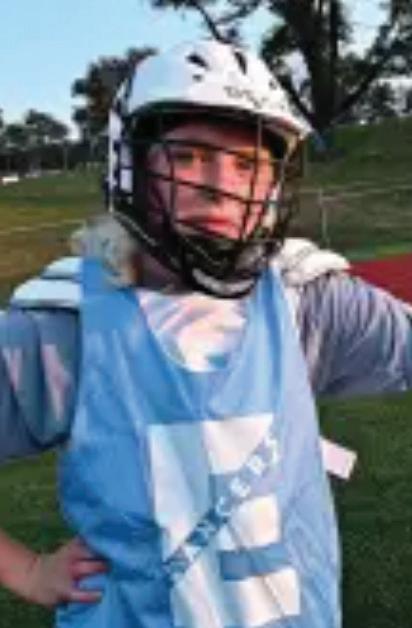





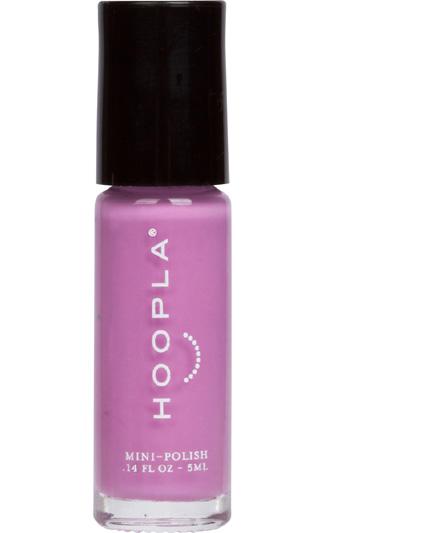

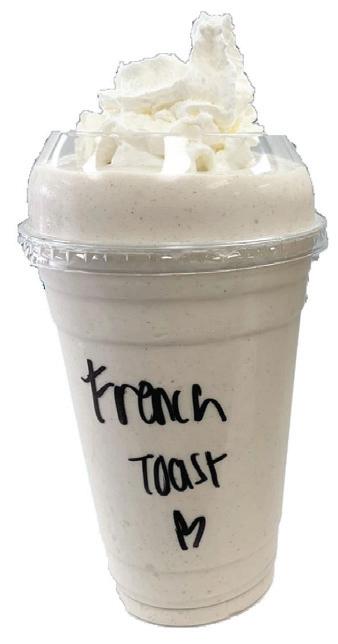


To start a more inclusive tradition, homecoming royalty now consists of four candidates regardless of gender rather than the traditional king and queen
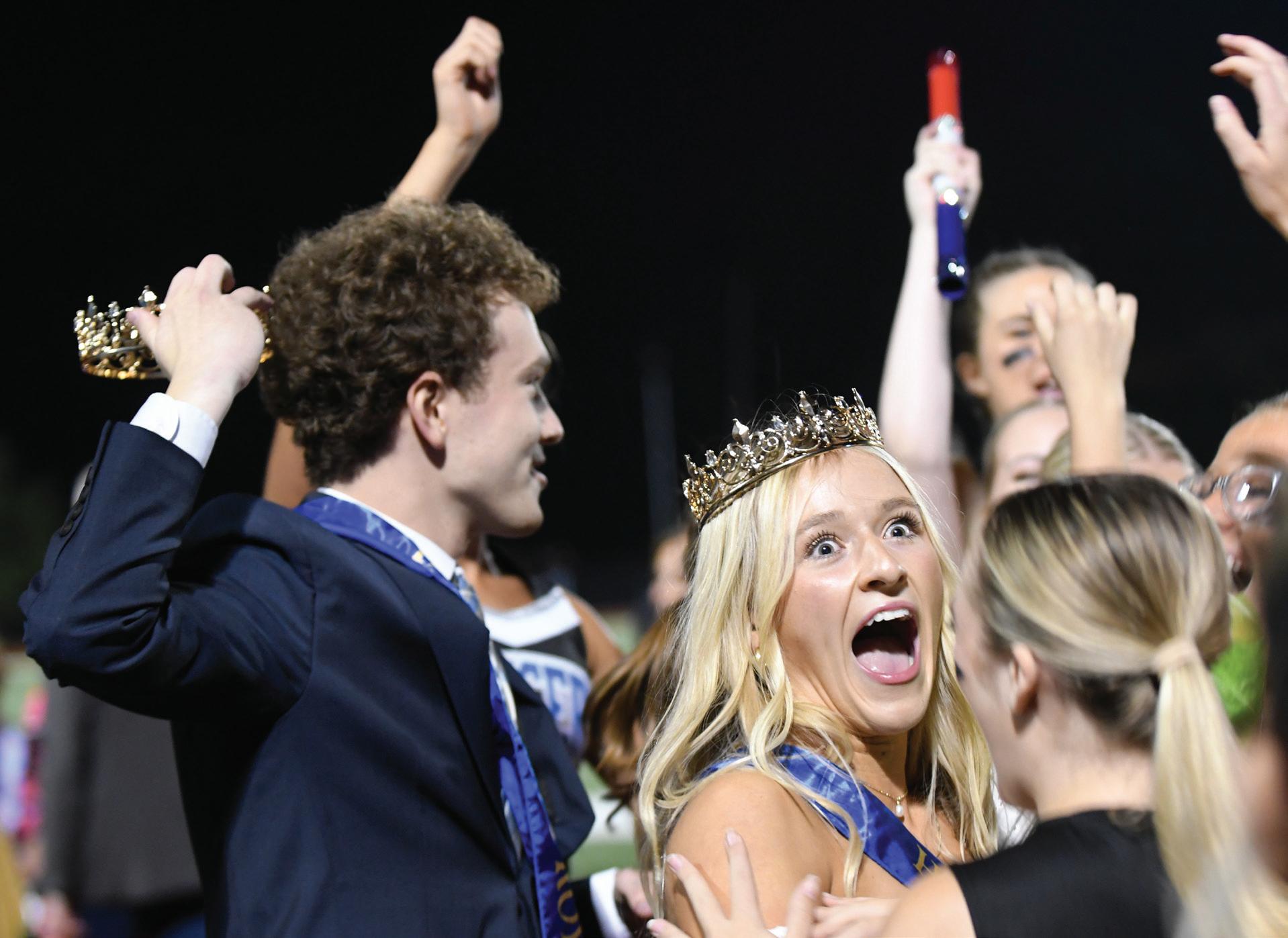
ABOVE Sophomore Lucy Pace, senior Greta Dickerson and senior Emily Winter hold up signs supporting their cheer teammate, Samantha Herpich, as she walks out with her family. “She’s a really good leader and just a good person for everyone to look up to because she works hard all the time and always brings good attitudes,” Winter said. “We wanted to make sure she was really well recognized.” photo by I riley eck

ABOVE Junior Marissa Liberda takes a photo of the four homecoming royals to post on the Harbinger social media. Liberda was broadcasting the game and halftime on the Harbinger Instagram. “The number four [for royalty] was decided upon as long as there was a break between the number four and five. If the vote had been very close, we would have taken the top five or six,” said STUCO sponsor Brenda Fishman. photo by I charlotte emley
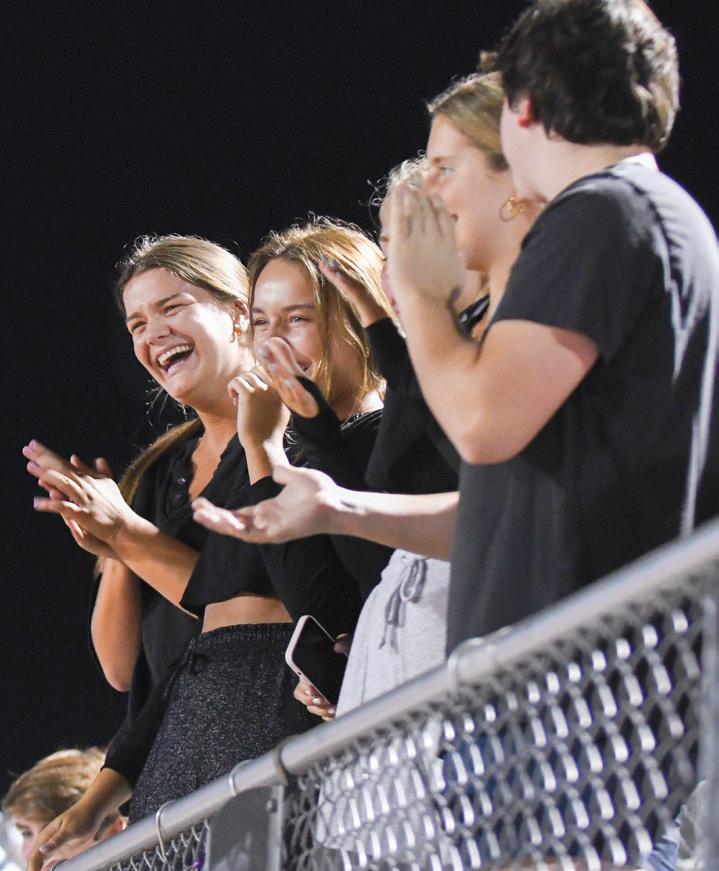

LEFT Senior Macy Crosser is given a sash by last year’s homecoming king, Octavio Galicia. Each member of royalty was given a homecoming royalty sash and crown. photo by I riley eck
 LEFT Seniors Emily Pollock and Abry Steinbrecher clap after Afa Akwanka is announced as the first member of the Homecoming Royalty, which were listed in alphabetical order. photo by I caroline martucci
Use this QR code to purchase photos from this event on Harbie Photo
TOP LEFT Senior Kate Cronenwett reacts to her dance teammates surrounding her after being crowned for homecoming royalty. photo by I caroline martucci
design by rachel bingham
LEFT Seniors Emily Pollock and Abry Steinbrecher clap after Afa Akwanka is announced as the first member of the Homecoming Royalty, which were listed in alphabetical order. photo by I caroline martucci
Use this QR code to purchase photos from this event on Harbie Photo
TOP LEFT Senior Kate Cronenwett reacts to her dance teammates surrounding her after being crowned for homecoming royalty. photo by I caroline martucci
design by rachel bingham
